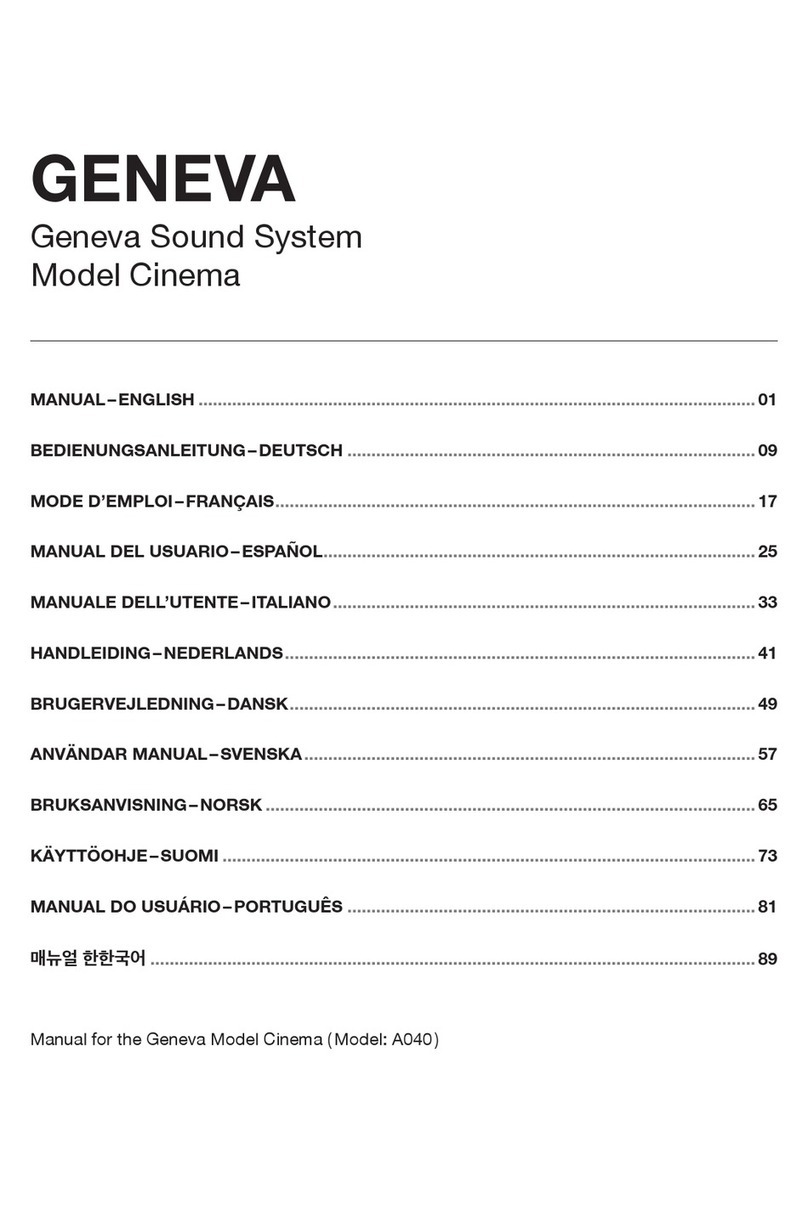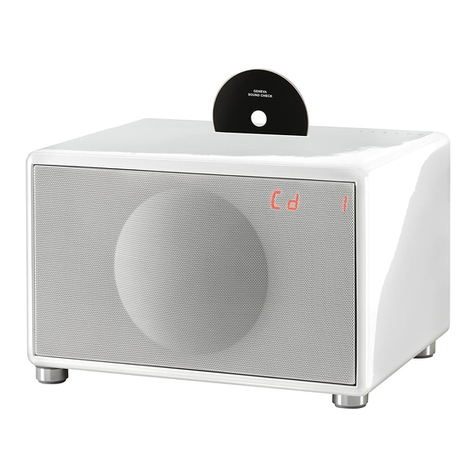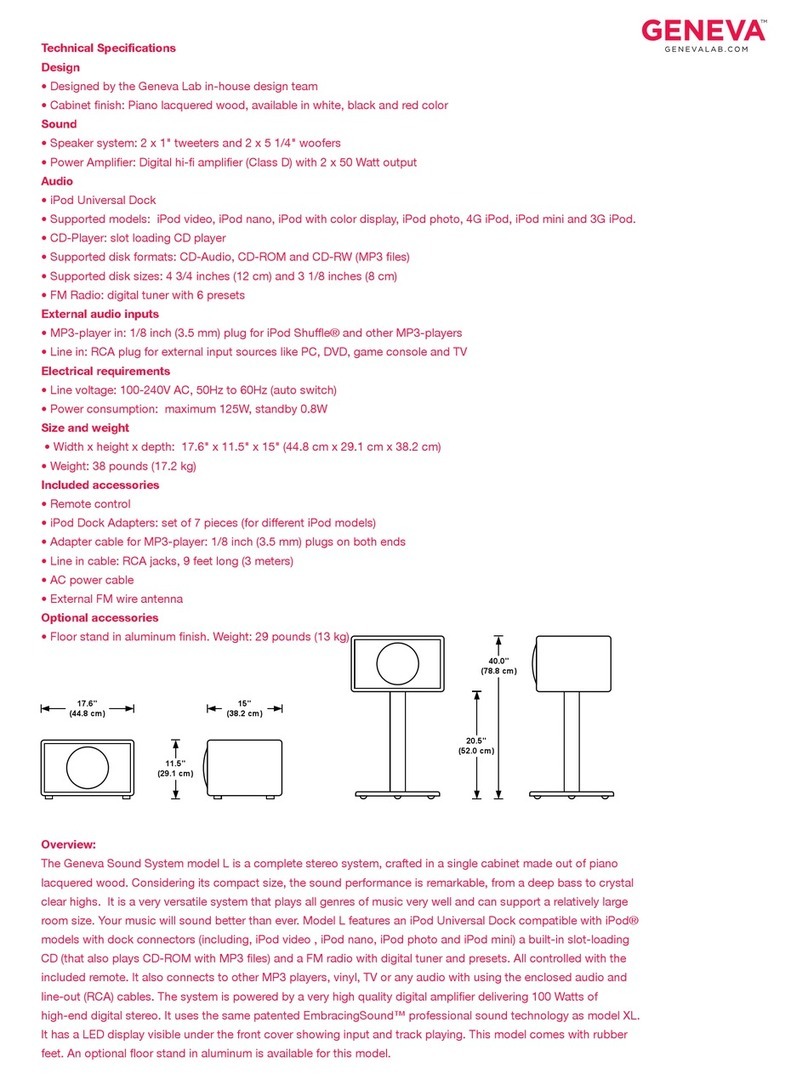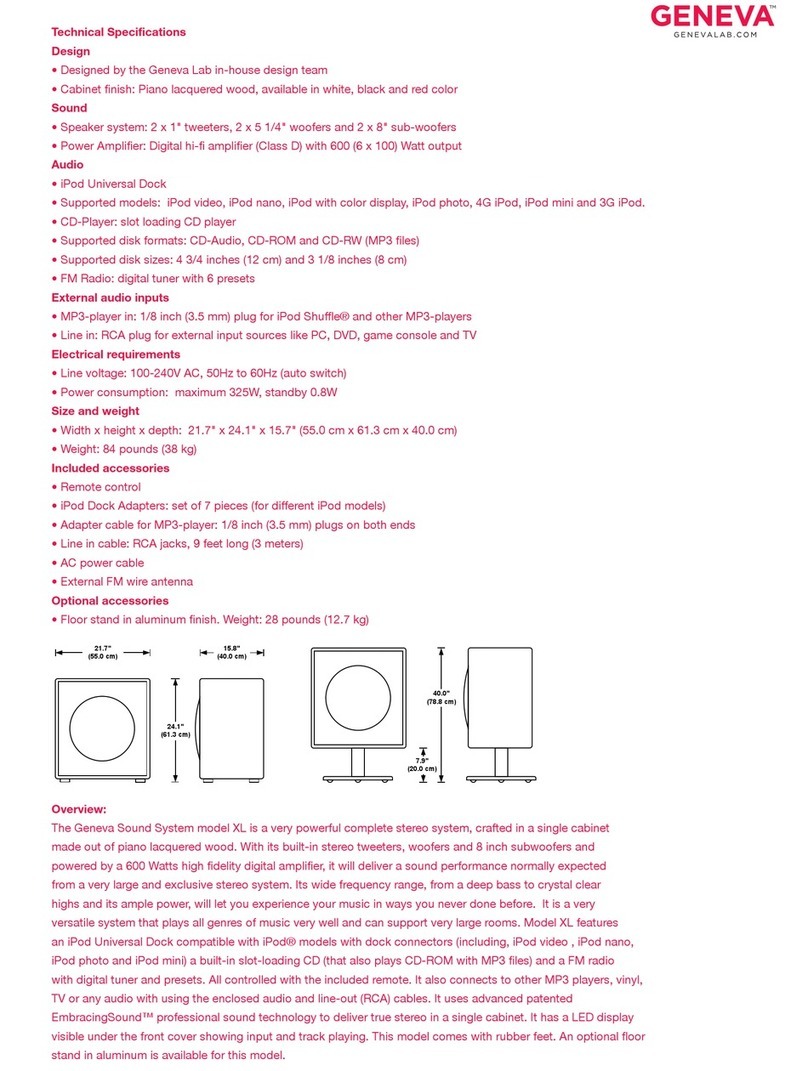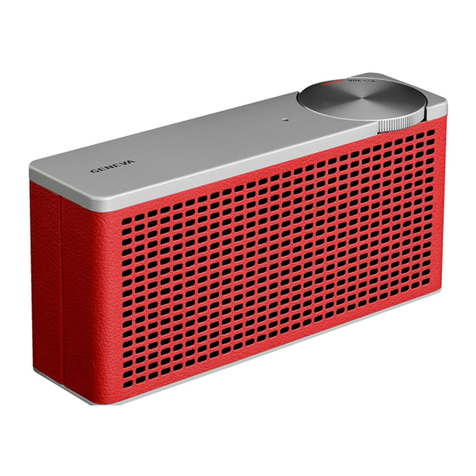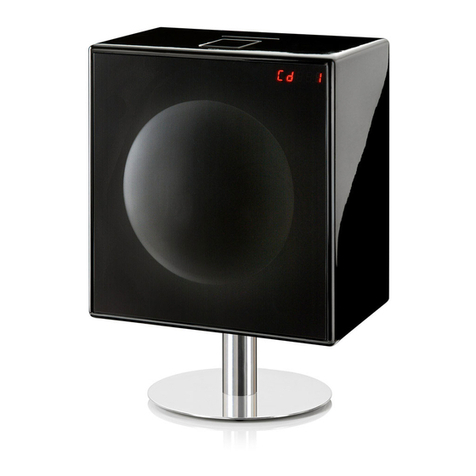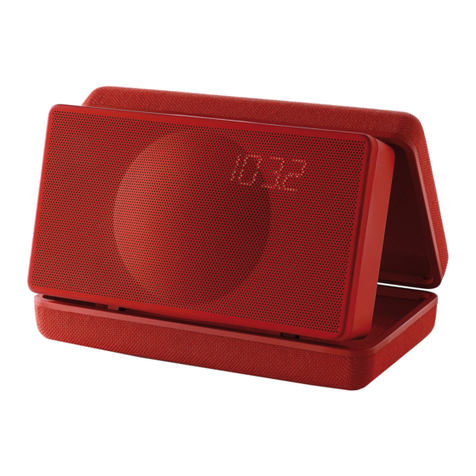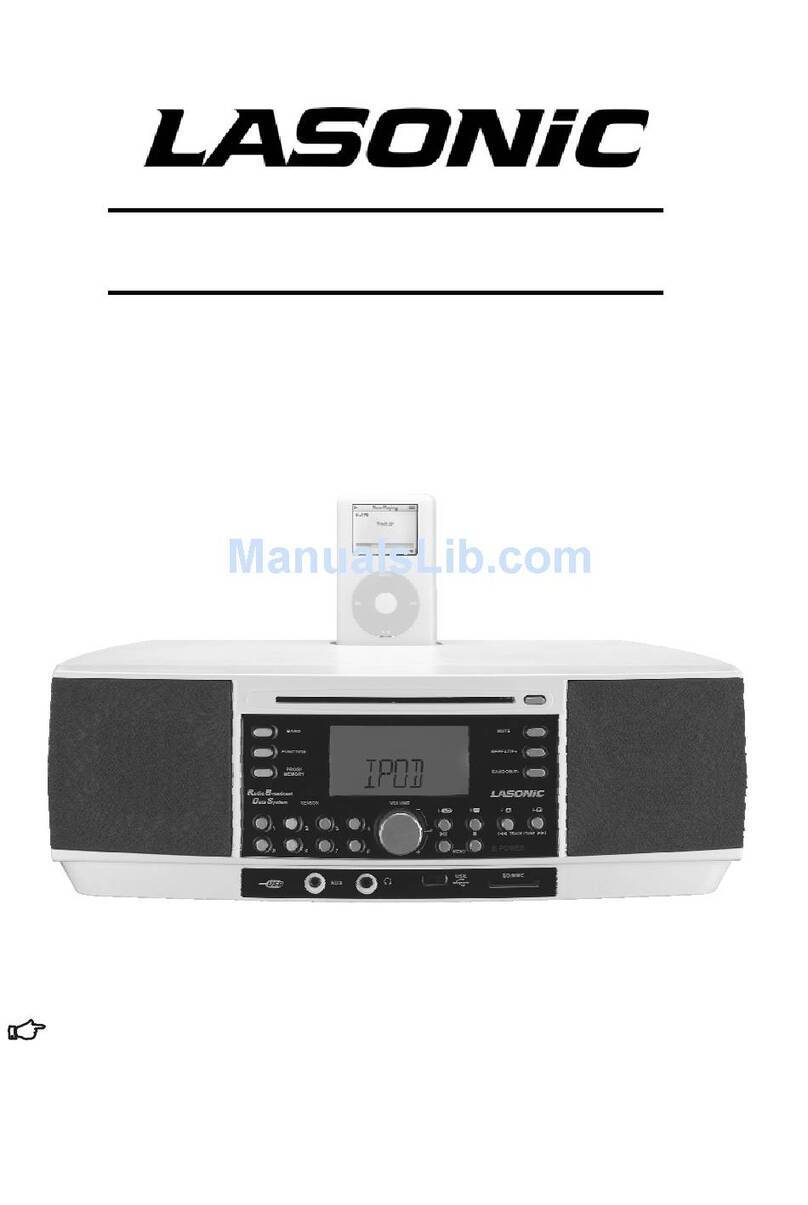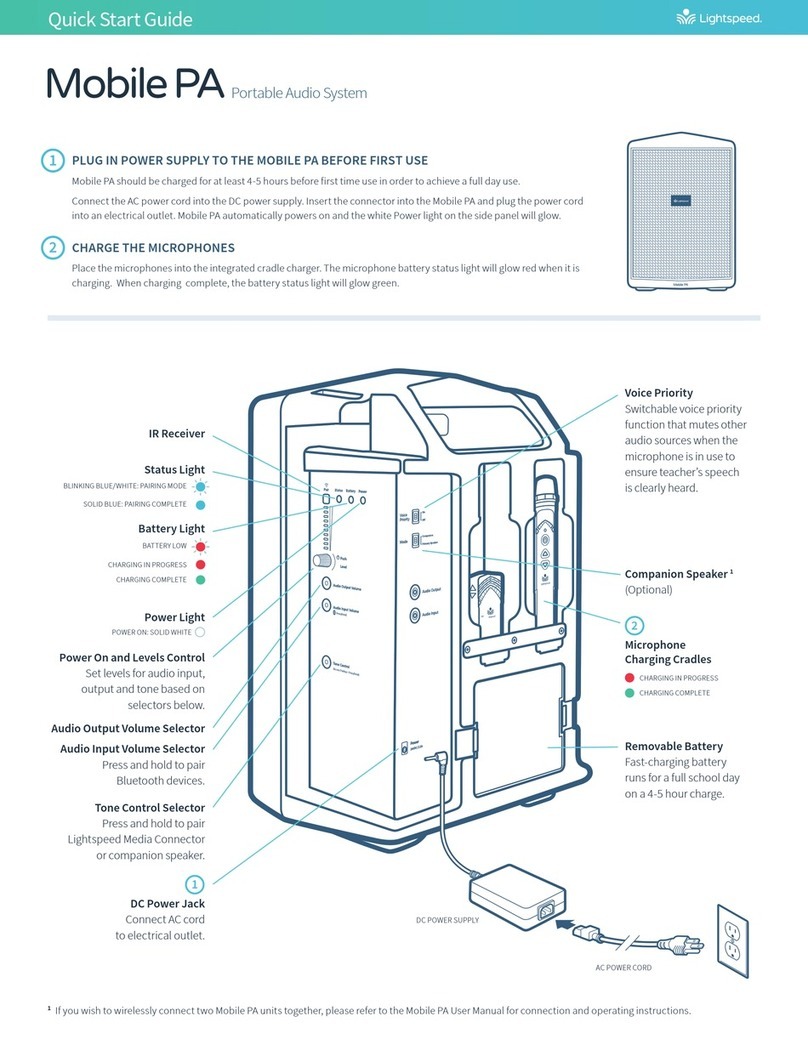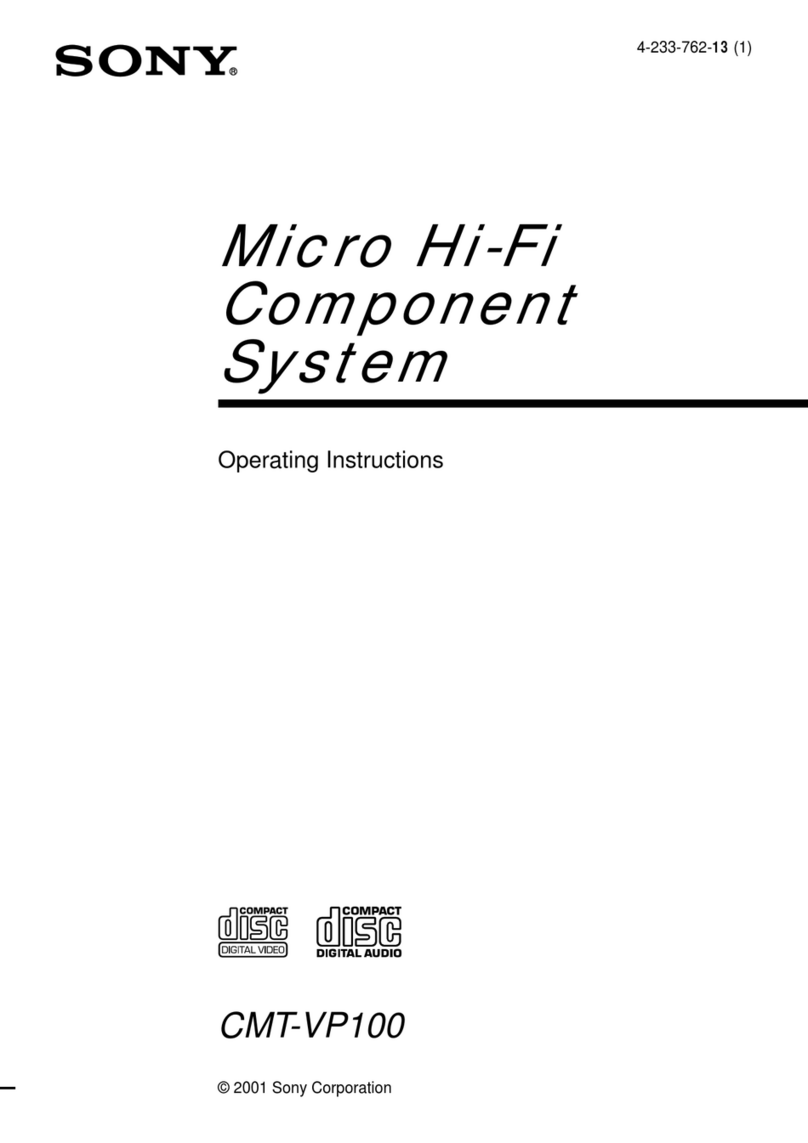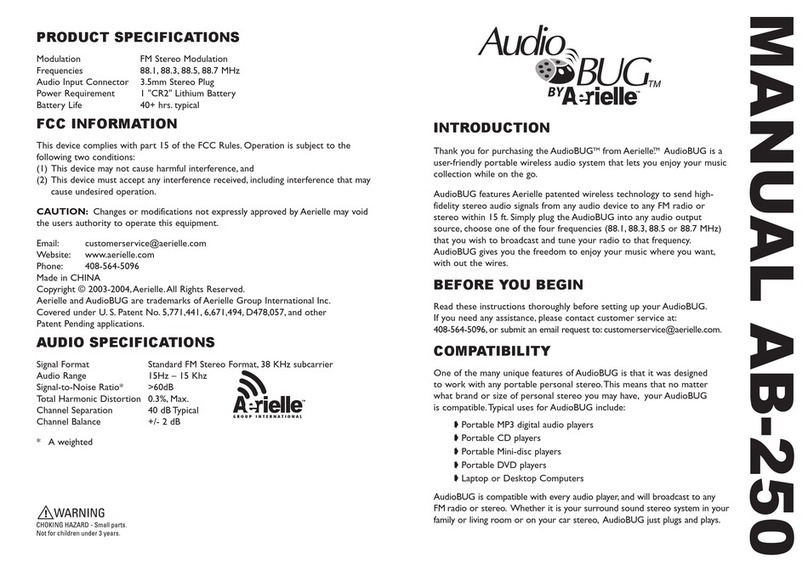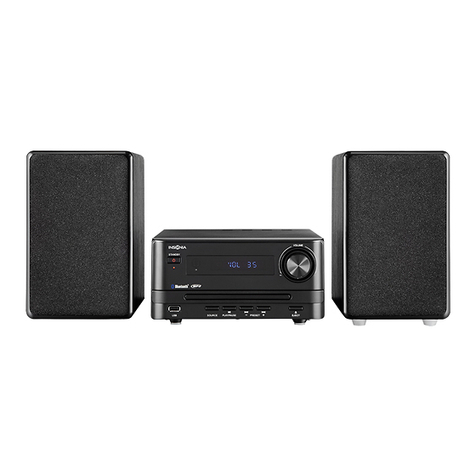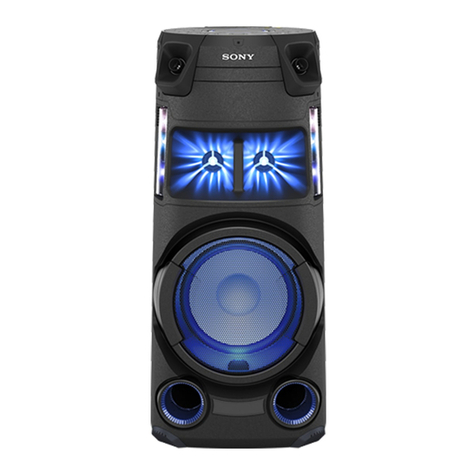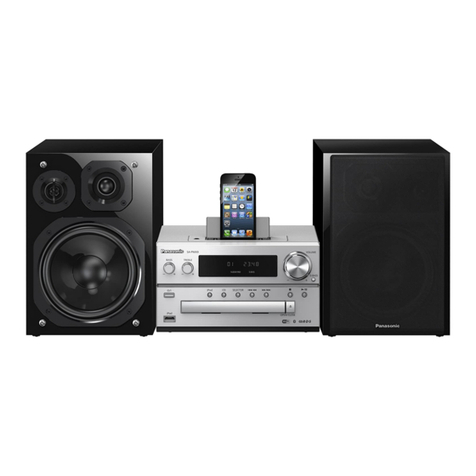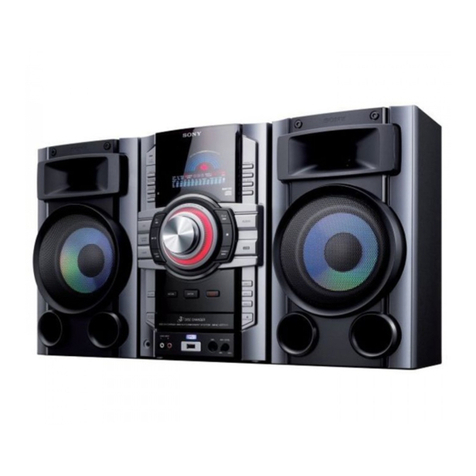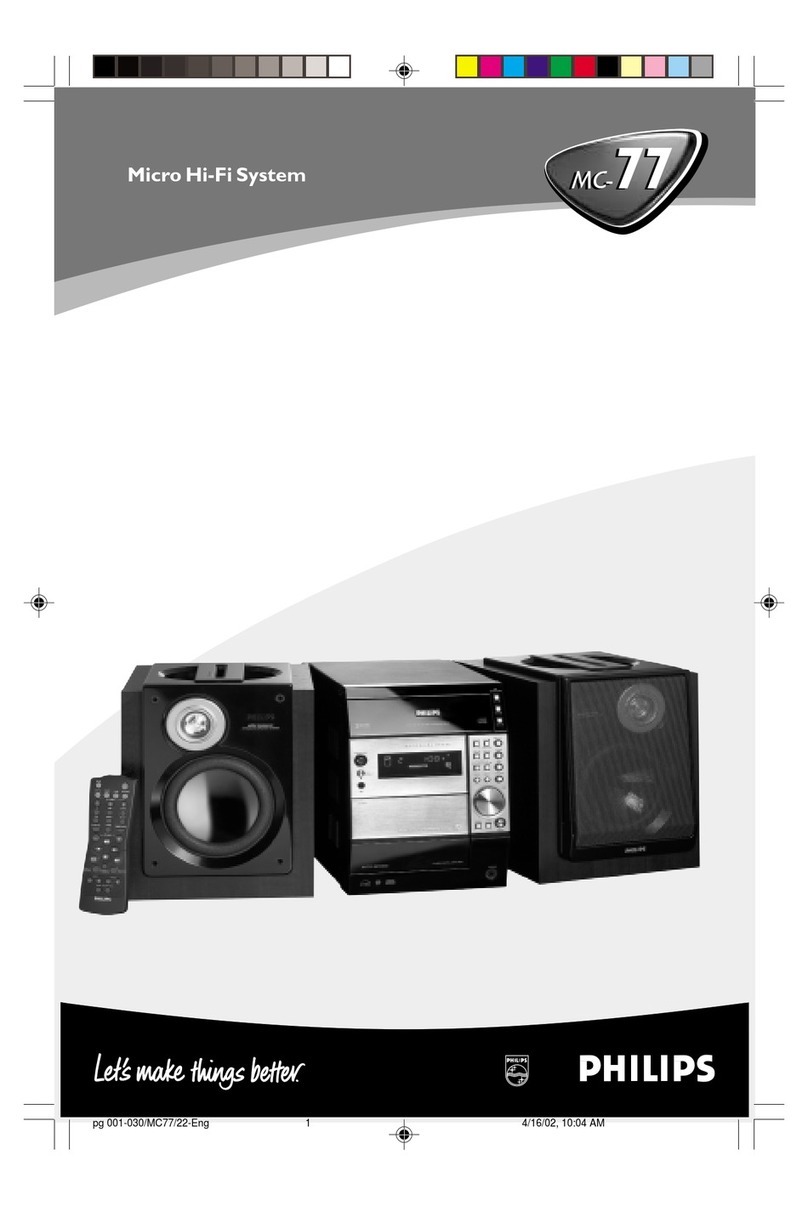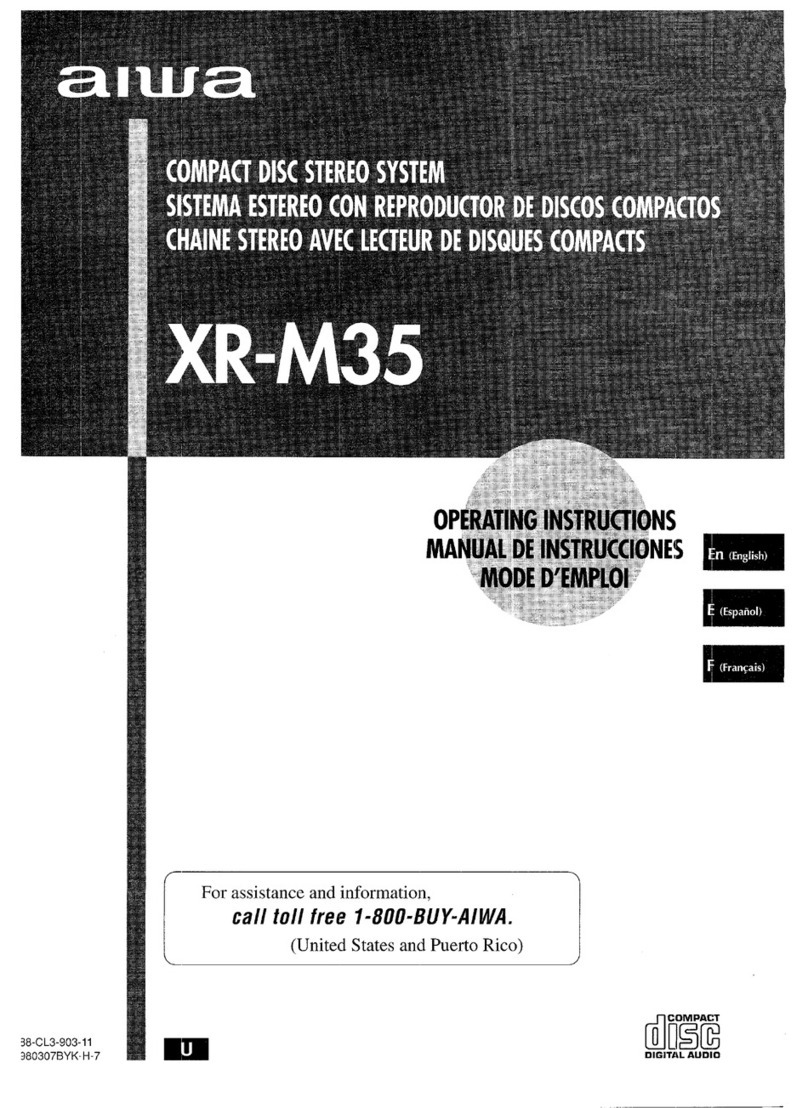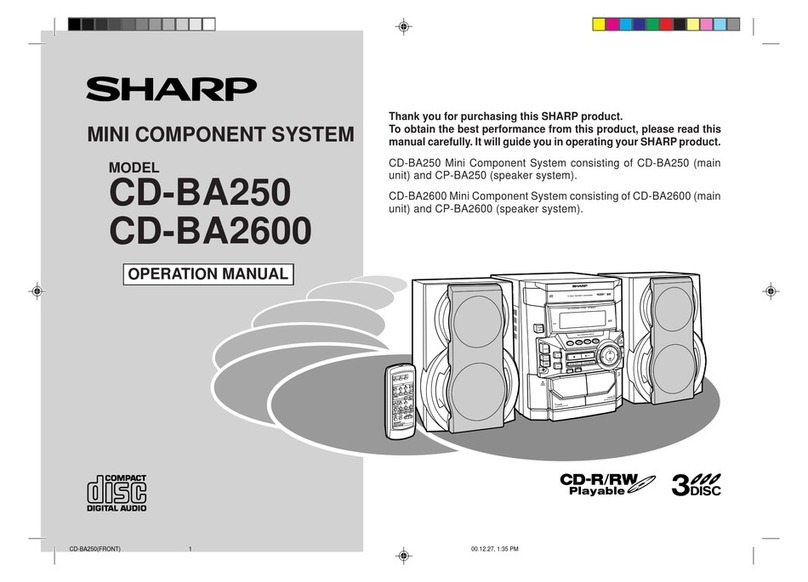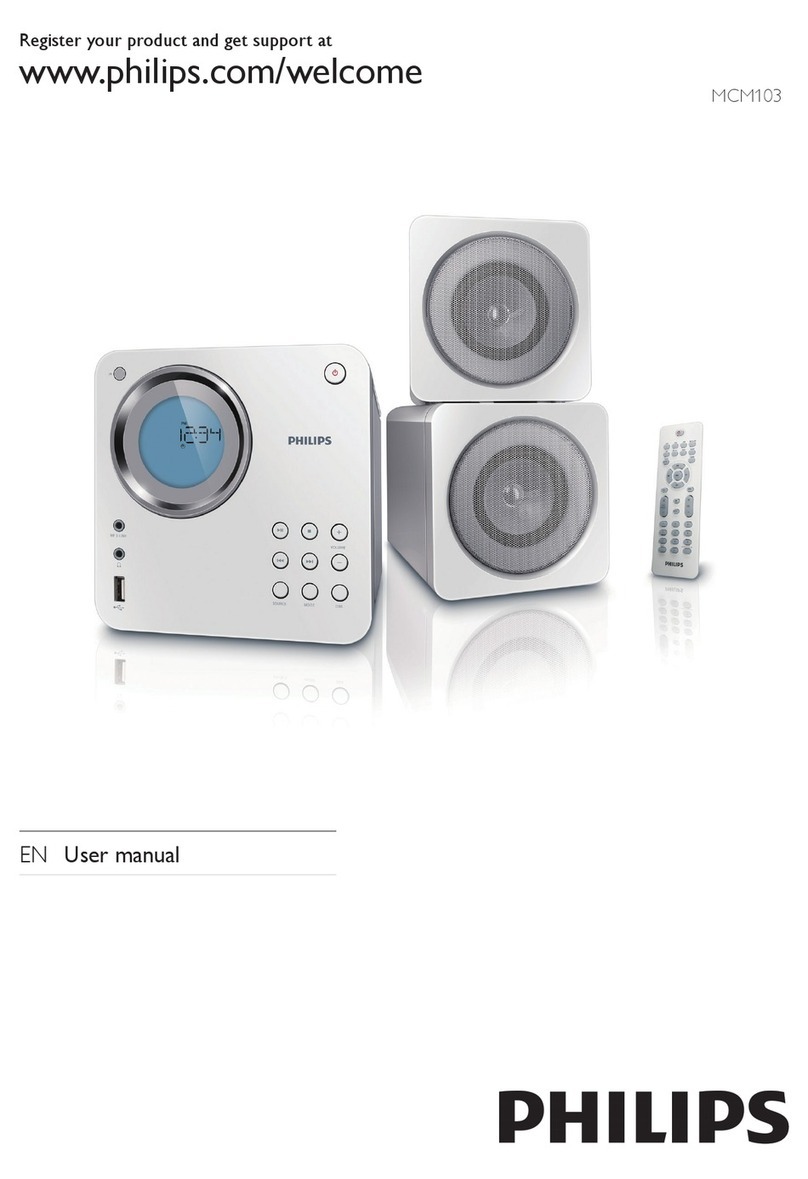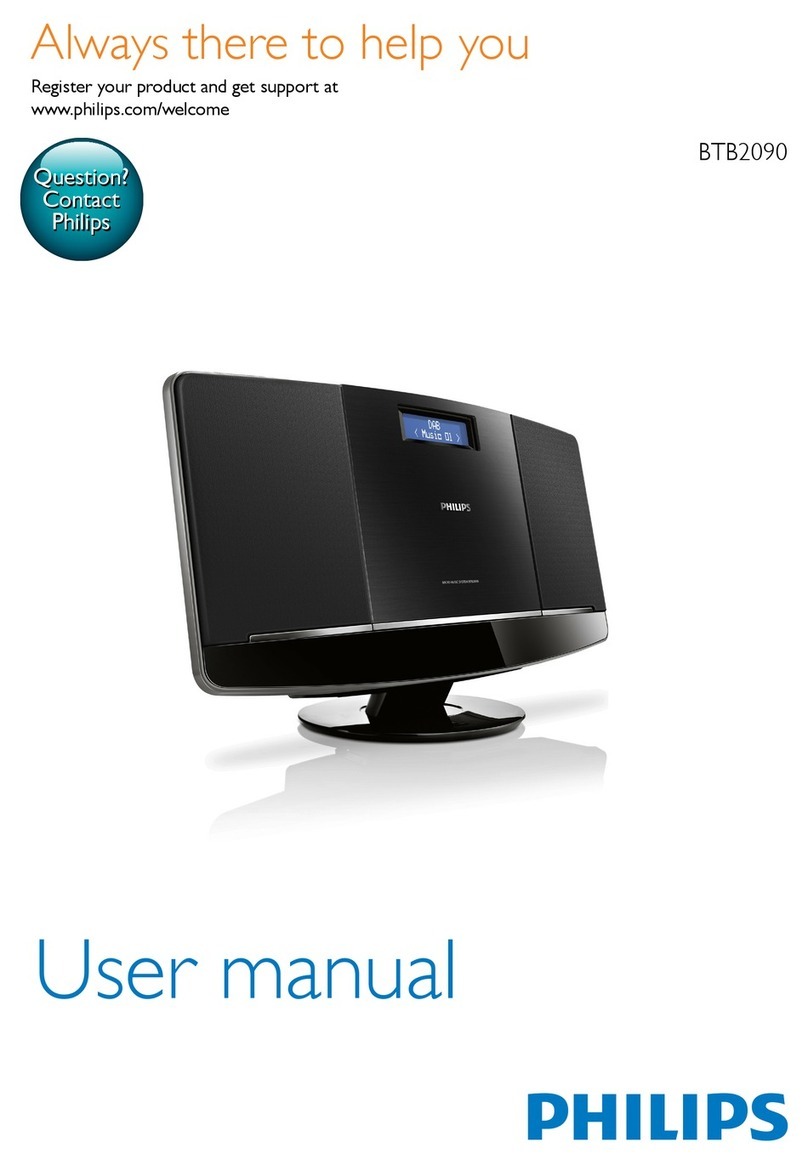Geneva M User manual

1
User Manual
Geneva Sound System
(Model M)


3
English
IMPORTANT SAFETY INSTRUCTIONS
Batteries in the remote control: Keep the remote control battery
away from children. It may cause a re or chemical burn if
mishandled. Do not recharge, disassemble, heat above 212ºF
(100ºC), Replace only with a battery of the correct type and model
number (CR2025 lithium coin cell battery, 3 V).
CAUTION: Risk of explosion if battery is replaced incorrectly.
Used batteries: Please dispose of used batteries properly,
following the local regulations. Do not place the battery in re.
Outside Antenna: If an outside antenna or cable system is
connected to this product, be sure the antenna or cable system is
grounded so as to provide some protection against voltage surges
and built-up static charges. Article 810 of the National Electric
Code, ANSI/NFP No. 70 information, Section 54 of the Canadian
Electrical Code, with regard to proper grounding of the mast and
supporting structure, grounding of the lead-in wire to an antenna
discharge unit, size of grounding conductors, location of antenna/
discharge unit, connection to grounding electrodes, and require-
ments for the grounding electrode.
Note to CATV system installer: This reminder is provided to call
the CATV system installer’s attention to Article 820-40 of the NEC
(of USA) that provides guidelines for proper grounding. In particular,
it species that the cable ground shall be connected to the
grounding system of the building, as close to the point of cable
entry as is practical.
This product can be recycled. Products bearing this symbol must
NOT be thrown away with normal household waste. At the end of
the product’s life, take it to a collection point designated for
recycling of electrical and electronic devices. Find out more about
return and collection points through your local authority.
The European Waste Electrical and Electronic Equipment (WEEE)
Directive was implemented to dramatically reduce the amount of
waste going to landlls, thereby reducing the environmental impact
on the planet and on human health. Please act responsibly by
recycling used products. If this product is still usable, consider
giving it away or selling it.
1) Read, keep and follow these instructions.
2) Install in accordance with the manufacturer’s instructions.
3) Keep the heat dissipator at the bottom side away from heat
sensitive materials.
4) Do not install near any heat sources such as radiators, heat
registers, stoves, or other apparatus (including ampliers) that
produce heat.
5) Only use attachments/accessories specied by the
manufacturer.
6) Protect the power cord from being walked on or pinched,
particularly at plugs, convenience receptacles, and the point
where they exit from the apparatus.
7) Unplug this apparatus during lightning storms or when unused
for long periods of time.
8) Do not let objects or liquids enter the product.
9) Refer all servicing to qualied service personnel. Servicing is
required when the apparatus has been damaged in any way, such
as power-supply cord or plug is damaged, liquid has been spilled
or objects have fallen into the apparatus, the apparatus has been
exposed to rain or moisture, does not operate normally, or has
been dropped.
10) Opening the unit by unauthorized personnel will void the
limited warranty.
CAUTION: Use of controls or adjustments or performance of
procedures other than herein may result in hazardous radiation
exposure or other unsafe operation.
Cleaning: Use a soft, dry cloth to avoid making scratches to
the surface. Do not use cleaning alcohol, or other solvent uids
to clean the surface of the Cabinet as this can both damage the
lacquer and also cause electrical failures and re if it enters the
electronics in the Geneva Sound System! Before cleaning, please
unplug this Geneva Sound System from the AC power outlet.
Overloading: To prevent risk of re or electric shock, avoid
overloading wall outlets or extension cords.
Open re: Keep this Geneva Sound System a safe distance away
from any open ame such as a lit candle. No open ame sources,
such as lighted candles, should be placed on the Geneva Sound
System.
Operating Temperatures: The recommended operating tempe-
rature range for the Geneva Sound System is 41 to 104 degrees
Fahrenheit (5 to 40 degrees Celsius).
Front grille panel: Never remove front grille panel because the
panel is non detachable and will void the limited warranty.
Label location: The product labels and safety related markings
are located on the bottom plate of the Geneva Sound System.
Unplugging while in operation: Do not remove the AC power
cord if music is playing.

4
1. Getting Started
Step 1: Unpack all components from the shipping box. Please save
the original packaging material in case you ever need to return
the system since the Limited Warranty does not cover shipping
damages.
Step 3: Connect the enclosed external telescopic antenna. You
will nd the antenna connector in the Geneva Sound System back
panel (see picture below).
The shipping box should contain the following system
components:
Step 4: Connect the AC power cable to the AC power plug on the
back panel (see picture). Then connect the other end of the AC
power cable to an AC outlet. „12:00“ will blink on the display,
indicating an invalid time setting.
Step 2: Remove the protection paper from the remote control
battery compartment.
Line In Antenna connector AC plug
Touch Panel:
Turn on the Geneva Sound System:
Press the key on the remote control or touch the key on
the touch panel.
How to verify that the remote control works?
Every time a key is pressed on the remote control, a small red light
quickly lights up on the display.
Adjust the clock:
1. Press the key on the remote control. The letter „C“ should
start blinking on the display.
2. Use the and keys on the remote control or the wheel to
set the correct time.
3. Press to complete the procedure.
Note: the clock remains valid for up to 1 hour of power loss.
Remote Control:
Telescopic
Antenna
iPhone adapter
Power cord
Line cable
Remote control
Treble control
Bass control
Play / Pause
Fast reverse/
skip backward
FM/
radio presets
Power On / Off
Volume control
Clock control keys
Fast forward/
skip forward
iPod Line in
FM Radio
iPod Menu key
Fast reverse / skip
backward
Power On / Off
Play / Pause
Fast forward/skip
forward
iPod control and volume
Mode selector
Dock adapter
iPod dock
Touch panel
ON / OFF key
Display

5
English
2. Listening to the iPod
Step 1. To use the Geneva Sound System with an iPod, select
iPod as the audio source using the or key: The display
under the grille should display “no iPod”.
Step 2. Insert the correct iPod adapter: Attach the Dock Adapter
to the iPod Universal Dock by pressing lightly on the top of the
Dock Adapter (see picture) and it will snap in:
How to select the right iPod adapter for my iPod?
Use the iPod adapter provided with your iPod. Only if an
iPhone has to be docked, use the iPhone adapter provided
with the Geneva Sound System.
Step 3. Insert the iPod into the iPod dock. The display should now
show „iPod“.
Step 4. Press the key on the remote control or on the Touch-
Light panel. If you still cannot hear any sound, check that the volu-
me is turned up by adjusting the key or the TouchLight wheel.
Step 5. You can control your iPod using the , , keys
on your remote control or the TouchLight controls on the system.
Step 6. The key on the TouchLight offers full control of the
iPod menu levels. Tap the menu key to navigate through iPod op-
tions. The TouchLight wheel is used to move up and down within a
menu. To select an item, tap the wheel.
Charging: Your iPod is charging while the system is connected to
an AC plug.
How to adjust volume and sound?
1. Use the , , , , , keys on the remote
control (or the touch panel wheel for the volume only) to adjust
sound and volume.
2. Volume: 0 means silence, 100 means maximum output.
3. Treble and Bass: -6 means very little Bass or Treble, 0 means
neutral, 6 means maximum effect.
4. If you turn the device off, the current values are stored.
3. Listening to the FM radio
Step 1. Select FM radio as the audio source using the or
key on on the remote control or on the TouchLight; the display
under the grille should display an FM frequency, e.g. “103.2”. If
you cannot hear any sound, check the volume setting by pressing
the key.
Step 2. Select an FM station with the and keys: one click
increases or decreases the frequency by 100 kHz. The number on
the display under the grille indicates the current frequency in MHz
(e.g. “88.7“ on display means 88.7 MHz). Hold down the or
the key and the FM radio will search for the next station au-
tomatically. When a station has been found, the automatic search
stops. To keep scanning, repeat this action.
How to switch between mono and stereo?
Press the button for 1 second to toggle between mono and
stereo mode.
How to store / recall a radio station (presets)?
1. Select your favorite radio station using the or keys on
the remote control or on the TouchLight.
2. Select one of the 6 preset keys on the remote control, and keep
pressing it until the corresponding letter on the display starts
blinking. The station has now been stored and can be recalled by
pressing the same preset key.
How to erase or overwrite a preset?
Stored presets do not need to be erased - just use the previous
steps to store a new station in a preset.
4. Using the Line Input
1. Use a cable with a 3.5mm jack to connect the Geneva Sound
System to any audio device that has an audio out connector.
First connect the cable to the source, then connect the cable
to the Line In connector located on the back panel of the
Geneva Sound System.
2. Switch the Geneva Sound System to Line in mode using
the on the TouchLight or key and activate the
connected audio source. Note that you cannot control any
connected device using the Geneva Sound System remote
control, just the volume settings.
3. Adjust the output volume of the connected device.

6
5. Using the Alarm
How to set the Alarm?
1. Push the key on the remote control: a blinking „A“ should
appear on the display.
2. Select the desired alarm time using the and keys on
the remote control or on the cabinet.
3. Push again the key on the remote control to store the alarm
time; „A“ indicates alarm active.
Note: An alarm can be set only if the clock has been adjusted as
described above in Chapter 1.
The alarm will use the latest mode and setting. If you are in iPod
mode, the alarm will awaken in iPod mode; if in FM it will awaken
to the FM station selected; if neither iPod nor FM are chosen, it
will awaken with a beeping tone.
How to switch the Alarm on and off?
Use the key to activate / deactivate the alarm; „A“ indicates
alarm active.
How to snooze and acknowledge the Alarm?
While the alarm is active, touch anywhere on the TouchLight panel
to snooze the alarm for ten minutes. To acknowledge the alarm
push, any key on the remote control. Without acknowledgement,
the unit will automatically go to stand-by mode after playing for 20
minutes.
6. Troubleshooting, Service and Support
How to change the remote control battery?
1. Open the battery lid of the remote control.
2. Remove the used battery and replace it with a new lithium cell,
3 V battery (CR2025 type).
3. Respect the polarity indication.
Troubleshooting and Support:
1. If the system does not work as expected, rst carefully read this
manual.
2. If the problem persists, you can access our troubleshooting
database available on the web at www.genevalab.com and
select support page.
3. If still not successful, contact our customer support.
Service and Repair:
If the product is damaged and needs repair, please contact Gene-
va Lab by phone or email to be referred to an authorized service
center. For repair under the limited warranty period, see terms
on the web at www.genevalab.com and select support page or
consult your dealer.
Step 1
Step 2 + 3
Customer Service:
see Geneva Lab Website www.genevalab.com and select
support page for your local support number.
7. Made for iPod & Technology Partners
The “Made for iPod and iPhone“ logo indicates that this product has
been designed speci cally to work with iPod and the iPhone.
The manufacturer certi es that this accessory has been made in
accordance with the high standards of quality and performance that
you expect from iPod and Apple.
Technology Partners:
Geneva Lab Corporation uses some of the world’s leading devel-
opers of audio technologies to make the Geneva Sound System a
very advanced product.
“EmbracingSound™ is the technology for consumers and professi-
onals alike to experience sound. As EmbracingSound™ is utilizing
two very closely spaced speakers you will experience what is really
in the recording with better resolution and clarity than ever before.
Just sit back and experience all your music and you will most pro-
bably nd new favorites as well as making excursions in to music
genres that you where totally unfamiliar with before. Just let the
experience guide you!
More details can be found on the www.genevalab.com website.
8. Technical Speci cations
For detailed technical speci cations for this product, please visit
our website (www.genevalab.com) and select support page, where
you can download the detailed technical speci cations for any of
our products.
© 2010 G-Lab GmbH. All rights reserved
Under the copyright laws, this manual may not be copied, in whole
or in part, without the written consent of G-Lab GmbH.
Geneva® is a registered trademark of G-Lab GmbH.
iPod is a trademark of Apple Computer, Inc. registered in the U.S.
and other countries.
The trademark EmbracingSound™ and the Embracing Sound Expe-
rience logo are owned by Embracing Sound Experience AB.
Geneva Sound System Model M, User Manual, Version v1.0

7
Deutsch
WICHTIGE SICHERHEITSHINWEISE
gitter, da es nicht abnehmbar ist und durch ein Enfernen die
Garantie verfällt.
Anbringungsstelle der Plakette: Die Produktplakette und Sicher-
heitsmarkierungen sind an der Bodenplatte der Geneva Tonanlage
angebracht. Diese dürfen nicht entfernt werden.
Ziehen des Steckers bei laufendem Gerät: Ziehen Sie den
Stecker während des Abspielens von Musik nicht aus der Steckdose.
Batterien in der Fernbedienung: Bewahren Sie die Fernbedienung
außerhalb der Reichweite von Kindern auf. Sie kann, wenn sie
unsachgemäß gehandhabt wird, einen Brand oder chemische
Verätzungen verursachen. Die Batterie nicht wieder auaden, nicht
zerlegen und nicht über 100° C (212° F) erhitzen. Ersetzen Sie die
Batterie nur durch eine neue vom richtigen Typ und mit der richtigen
Modellnummer (CR2025 Lithium-Knopfzellenbatterie 3 V).
Achtung: Wenn die Batterie unsachgemäß ausgetauscht wird,
besteht Explosionsgefahr.
Gebrauchte Batterien: Bitte entsorgen Sie gebrauchte Batterien
ordnungsgemäß entsprechend den in Ihrem Land geltenden
Vorschriften. Werfen Sie die Batterie nicht ins Feuer.
Außenantenne: Wenn an dieses Produkt eine Außenantenne bzw.
ein Kabelsystem angeschlossen wird, achten Sie darauf, dass die
Antenne bzw. das Kabelsystem geerdet ist, so dass ein Schutz gegen
Spannungsanstiege und aufgebaute elektrostatische Ladungen be-
steht. (Artikel 810 des Nationalen Stromgesetzes, Information ANSI/
NFP Nr. 70, Abschnitt 54 des kanadischen Stromgesetzes bezüglich
der ordnungsgemäßen Erdung des Masts und der Halterungsstruktur,
Erdung des eingehenden Drahts zu einem Antennen-Entladungsge-
rät, Größe von Erdungsleitungen, Standplatz von Antenne/
Entladungseinheit, Anschluss an Erdungselektroden und
Anforderungen für die Erdungselektrode.)
Anmerkung für den Installateur des CATV-Systems: Dieser
Hinweis wird geliefert, um die Aufmerksamkeit des Installateurs des
CATV-Systems auf Artikel 820-40 des NEC (in den USA) zu lenken,
das Richtlinien für die fachgerechte Erdung enthält. Insbesondere
gibt sie an, dass das Erdungskabel so nahe wie möglich am
Eintrittspunkt des Kabels an das Erdungssystem des Gebäudes
angeschlossen werden soll.
Dieses Produkt kann wiederverwertet werden. Produkte, die
dieses Symbol tragen, dürfen NICHT in den normalen Hausmüll
weggeworfen werden. Bringen Sie das Produkt zu Ende seines
Lebenszyklus zu einer Sammelstelle für die Wiederverwertung von
Elektro- und elektronischen Geräten. Informationen zur Rückgabe
und zu Sammelstellen erhalten Sie bei Ihrer örtlichen Behörde.
Die europäische Richtlinie für Entsorgung von Elektro- und elektro-
nischen Geräten (WEEE) wurde implementiert, um die Menge des
Mülls auf Mülldeponien drastisch zu senken und damit die Umwelt-
auswirkung auf den Planeten und auf die menschliche Gesundheit zu
reduzieren. Bitte handeln Sie verantwortungsbewusst, indem
Sie gebrauchte Produkte der Wiederverwertung zuführen. Wenn
dieses Produkt noch benutzbar sein sollte, können Sie es auch
verschenken oder verkaufen.
1) Lesen und befolgen Sie diese Anleitungen und bewahren Sie
sie auf.
2) Installieren Sie das Gerät nach den Anweisungen des Herstellers.
3) Halten Sie die Wärmeableitung an der Unterseite des
Gerätes von hitzeempndlichen Stoffen fern.
4) Installieren Sie das Gerät nicht in Nähe von Wärmequellen
wie Radiatoren, Wärmespeichern, Öfen oder anderen Geräten
(einschließlich von Verstärkern), die Wärme erzeugen.
5) Benutzen Sie nur die vom Hersteller angegebenen
Anschlüsse/Zubehöre.
6) Schützen Sie das Stromkabel, damit man nicht darauf tritt oder
es gequetscht wird, insbesondere Steckern, Anschlussdosen und
am Punkt, wo die Kabel aus dem Gerät austreten. Insbesondere
achten Sie auf den festen Sitz des Netzsteckers am Gerät und
Steckdose.
7) Ziehen Sie bei Gewittern, oder wenn das Gerät über längere
Zeit nicht gebraucht wird, den Stecker des Geräts aus der
Steckdose.
8) assen Sie keine Gegenstände oder Flüssigkeiten in das Gerät
eindringen.
9) Beauftragen Sie mit allen Servicearbeiten nur qualiziertes
Servicepersonal. Ein Service ist erforderlich, wenn das Gerät
beschädigt wurde, etwa wenn das Stromkabel oder die Stecker
beschädigt sind, Flüssigkeit über dem Gerät verschüttet wurde,
oder Gegenstände in das Gerät gefallen sind, wenn das Gerät
Regen oder Feuchtigkeit ausgesetzt war, nicht normal funktioniert,
oder fallen gelassen wurde.
10) Wird das Gerät von unbefugtem Personal geöffnet wird, verfällt
die zeitlich begrenzte Garantie.
ACHTUNG: Die Benutzung von Steuerungen bzw. Leistungsein-
stellungen für Vorgänge, die nicht hier beschrieben sind, können zu
einer gefährlichen Strahlenbelastung oder zu anderen unsicheren
Betriebsbedingen führen.
Reinigung: Benutzen Sie ein weiches, trockenes Tuch, um ein
Verkratzen der Oberäche zu vermeiden. Verwenden Sie zum Rei-
nigen des Gehäuses keinen Alkohol oder andere Lösungsmittel, da
dadurch der Lack beschädigt und bei Eindringen in die Elektronik
der Geneva Tonanlage elektrische Defekte und sogar ein Brand ver-
ursacht werden können. Bitte ziehen Sie den Stecker der Geneva
Tonanlage aus der Steckdose, bevor Sie das Gerät reinigen.
Überlastung: Um die Feuergefahr und Belastung des Stromkreises
zu minimieren, benützen Sie keine Verlängerungskabel und stark
belastete Mehrfachsteckdosen.
Offenes Feuer: Halten Sie die Geneva Tonalage in einem sicheren
Abstand von offenen Flammen, wie etwa einer brennenden Kerze.
Auf die Geneva Tonanlage dürfen keine Quellen von offenen
Flammen, wie etwa brennende Kerzen, gestellt werden.
Betriebstemperaturen: Der empfohlene Bereich der Betriebstem-
peratur für die Geneva Tonanlage beträgt 5 bis 40 Grad Celsius
(41 bis 104 Grad Fahrenheit).
Vorderes Lüftungsgitter: Enfernen Sie nie das vordere Lüftungs-

8
1. Inbetriebnahme
Schritt 1: Packen Sie alle Bauteile aus dem Versandkarton aus.
Bitte bewahren Sie die Originalverpackung auf, falls Sie das Gerät
einmal einsenden müssen, da die beschränkte Garantie keine
Transportschäden abdeckt.
Schritt 3: Schließen Sie die beiliegende externe Teleskopantenne
an. Die Antennensteckbuchse nden Sie an der rückwärtigen Platte
der Geneva Tonanlage (siehe Abbildung unten).
Der Versandkarton sollte neben dem Model S folgende
Systembauteile enthalten:
Schritt 4: Schließen Sie das Wechselstromkabel an die
Strombuchse an der Gerätrückseite an (siehe Abbildung). Dann
stecken Sie das andere Ende des Stromkabels an eine Netz-
steckdose an. Auf dem Display blinkt nun „12:00“, wodurch eine
ungültige Zeiteinstellung angezeigt wird.
Teleskop-
antenne
Line in Kabel
iPhone Adapter
Stromkabel
Fernbedienung
Schritt 2: Entfernen Sie den Schutzstreifen aus dem Batteriefach
der Fernbedienung.
Line In Kabel Antennenstecker Wechselstromstecker
Touchpanel:
Wie kann man überprüfen, ob die Fernbedienung funktioniert?
Jedes Mal, wenn auf der Fernbedienung eine Taste betätigt wird,
leuchtet auf dem Display kurzzeitig ein kleines rotes Licht auf.
Einstellen der Uhr:
1. Drücken Sie auf der Fernbedienung die Taste . Auf dem
Display sollte der Buchstabe „C“ zu blinken beginnen.
2. Benutzen Sie auf der Fernbedienung die Tasten und
oder das Rad, um die richtige Zeit einzustellen.
3. Drücken Sie , um den Vorgang abzuschließen.
Hinweis: Die Uhr zeigt bis zu 1 Stunde nach Stromausfall noch die
richtige Zeit an.
Schalten Sie die Geneva Tonanlage ein:
Drücken Sie die Taste auf der Fernbedienung oder berühren
Sie die Taste auf dem Touchpanel.
Fernbedienung:
iPod Dock
Touchpanel
EIN & AUS Taste
Display
Höhensteuerung
Basssteuerung
Abspielen / Pause
Schneller Rück-
lauf/nach rückwärts
überspringen
Voreinstellungen
FM Radio
Strom Ein/Aus
Lautstärkenregelung
Uhreinstellungstasten
Schneller Vorlauf/
nach vor überspringen
iPod Line in
FM Radio
iPod -Menütaste
Schneller Rücklauf/nach
rückwärts überspringen
Strom Ein/Aus
Abspielen / Pause Schneller Vorlauf/
nach vor überspringen
iPod-Steuerung und
Lautstärke
Modusauswahl
Dock Adapter

9
Auswahl des richtigen iPod-Adapters für Ihren iPod
Benutzen Sie den iPod-Adapter, der mit Ihrem iPod mitgeliefert
wurde. Benutzen Sie den mit der Geneva Tonanlage mitgelieferten
iPhone-Adapter nur, wenn ein iPhone angeschlossen werden soll.
Schritt 3. Stecken Sie den iPod am iPod-Dock an. Das Display
sollte jetzt „iPod“ anzeigen.
Schritt 4. Betätigen Sie auf der Fernbedienung oder auf dem
Touchpanel die Taste . Sollten Sie noch keinen Ton hören
können, überprüfen Sie, ob die Lautstärke aufgedreht ist, indem
Sie diese mit der Taste oder mit dem Rad einstellen.
Schritt 5. Sie können Ihren iPod mit den Tasten , ,
auf der Fernbedienung oder auf dem Touchpanel steuern.
Schritt 6. Zum Durchsuchen des iPod benutzen Sie die Taste
und das Rad am Touchpanel. Ein Menüeintrag auf dem iPod wird
durch Antippen des Rades ausgewählt.
Laden: Ihr iPod lädt sich auf, während das System an eine
Wechselstrombuchse angeschlossen ist.
Deutsch
3. FM-Radio hören
Schritt 1. Wählen Sie mit den Tasten oder auf der Fern-
bedienung oder auf dem Touchpanel FM-Radio als Audioquelle aus.
Das Display unterhalb des Gitters sollte eine FM-Frequenz an-
zeigen, z.B. „103,2“. Wenn Sie keinen Ton hören können, über-
prüfen Sie die Lautstärkeneinstellung durch Drücken der Taste .
Schritt 2. Wählen Sie mit den Tasten und einen FM-Sender
aus: ein Klick erhöht bzw. verringert die Frequenz um 100 kHz. Die
Nummer auf dem Display unterhalb des Gitters zeigt die aktuelle
Frequenz in MHz an (z.B. „88,7“ auf dem Display bedeutet 88,7
MHz). Halten Sie die Taste oder gedrückt. Das FM-Radio
sucht dann den nächsten Sender automatisch. Wenn ein Sender
gefunden wurde, stoppt die automatische Suche. Zum Weiter-
suchen brauchen Sie diesen Vorgang nur zu wiederholen.
Mono und Stereo Auswahl:
Drücken Sie die Taste für 1 Sekunde, um zwischen Mono und
Stereo umzuschalten.
Speichern/Wiederaufrufen eines Radiosenders
(Voreinstellungen):
1. Wählen Sie mit den Tasten oder auf der Fernbedienung
oder auf dem Touchpanel ihren Lieblingssender aus.
2. Wählen Sie auf der Fernbedienung eine der 6 Voreinstellungs-
tasten aus und halten Sie diese gedrückt, bis der entsprechende
Buchstabe auf dem Display zu blinken beginnt. Der Sender ist
nun gespeichert und kann durch Betätigen dieser Vorein-
stellungstaste wieder aufgerufen werden.
Löschen bzw. Überschreiben einer Voreinstellung:
Gespeicherte Voreinstellungen brauchen nicht gelöscht zu werden.
Führen Sie einfach die obigen Schritte aus, um in einer
Voreinstellung einen neuen Sender zu speichern.
4. Benutzung des Eingangs Line In
1. Benutzen Sie zum Anschließen der Geneva Tonanlage an ein
Audio-Gerät, das eine Audio-Ausgangsbuchse hat, ein Kabel
mit einem 3,5 mm - Klinkenstecker. Schließen Sie das Kabel
zuerst an der Quelle und dann an der Line In – Buchse an der
Rückseite der Geneva Tonanlage an.
2. Schalten Sie die Geneva Tonanlage mit der Tasten oder
auf Line in-Modus um und aktivieren Sie die angeschlossene
Audioquelle. Beachten Sie, dass Sie ein angeschlossenes Gerät
nicht mit der Fernbedienung der Geneva Tonanlage steuern
können.
3. Stellen Sie die Lautstärke des angeschlossenen Gerätes ein.
Wie kann man die Lautstärke und den Klang einstellen?
1. Benutzen Sie auf der Fernbedienung die Tasten , ,
, , (oder das Rad am Touchpanel, wenn nur die
Lautstärke einzustellen ist), zum Einstellen von Ton und Laut
stärke.
2. Lautstärke: 0 bedeutet Stille, 100 bedeutet maximale Lautstärke.
3. Höhe und Bass: -6 bedeutet sehr wenig Bass bzw. Höhe, 0
bedeutet neutral, 6 bedeutet maximale Wirkung.
4. Wenn Sie das Gerät abschalten, werden die aktuellen Werte
gespeichert.
2. iPod hören
Schritt 1. Für die Benutzung der Geneva Tonanlage mit einem iPod
wählen Sie mit den Tasten oder als Audioquelle aus: Das
Display unterhalb des Gitters sollte „kein iPod“ anzeigen.
Schritt 2. Stecken Sie den richtigen iPod-Adapter an: Stecken
Sie den Dockadapter am Universaldock für iPod an, indem Sie
oben leicht auf den Dockdapter drücken (siehe Abbildung), bis er
einrastet:

10
5. Benutzung der Weckfunktion
Einstellen der Weckfunktion:
1. Drücken Sie auf der Fernbedienung die Taste : Auf dem
Display sollte ein blinkendes „A“ erscheinen.
2. Wählen Sie mit den Tasten und auf der Fernbedienung
oder auf dem Touchpanel die gewünschte Weckzeit aus.
3. Drücken Sie auf der Fernbedienung die Taste , um die Weck-
zeit zu speichern: „A“ zeigt an, dass die Weckfunktion aktiv ist.
Hinweis: Eine Weckzeit kann nur eingestellt werden, wenn die Uhr
wie in Kapitel 1 oben beschrieben eingestellt wurde.
Die Weckfunktion verwendet die letzte Einstellung. Falls der Audi-
opegel zu gering ist oder Lautstärke auf 0 steht, wird ein Weckton
generiert.
An- und Abschalten der Weckfunktion:
Benutzen Sie zum Aktivieren/Deaktivieren der Weckfunktion die
Taste : „A“ zeigt an, dass die Weckfunktion aktiv ist.
Abstellen und Bestätigen des Wecktons:
Wenn die Weckfunktion aktiv ist, können Sie zum Abstellen des
Wecktons für zehn Minuten jede beliebige Taste des Touchpanels
berühren. Zum Bestätigen der Weckfunktion drücken Sie eine
beliebige Taste auf der Fernbedienung. Ohne Bestätigung wird das
Gerät automatisch auf Standby schalten, nachdem es 20 Minuten
lang gespielt hat.
6. Fehlerbehebung, Service und Support
Austauschen der Batterie der Fernbedienung:
1. Öffnen Sie den Deckel des Batteriefachs an der Fernbedienung.
2. Entnehmen Sie die gebrauchte Batterie und ersetzen Sie sie
durch eine neue Lithium 3 V - Knopfbatterie (Typ CR2025).
3. Halten Sie sich dabei an die Anzeige der Polarität.
Fehlerbehebung und Support:
1. Lesen Sie, wenn die Anlage nicht wie erwartet funktionieren
sollte, zuerst diese Betriebsanleitung sorgfältig durch.
2. Sollte das Problem dadurch nicht lösbar sein, können Sie auf
unsere Datenbank für Fehlerbehebung zugreifen, indem Sie auf
www.genevalab.com gehen und dort die Support-Seite wählen.
3. Sollte auch das nicht erfolgreich sein, wenden Sie sich an
unseren Kundendienst.
Service und Reparatur:
Wenn das Produkt beschädigt sein sollte und repariert werden
muss, wenden Sie sich bitte telefonisch oder per E-Mail an Geneva
Lab, Sie werden dann an ein autorisiertes Service-Zentrum ver-
wiesen. Für Reparaturen während der Garantielaufzeit sehen Sie
die Bestimmungen im Internet auf www.genevalab.com nach und
wählen Sie dort die Support-Seite, oder wenden Sie sich an Ihren
Händler.
Kundendienst:
Gehen Sie auf die Webseite www.genevalab.com und wählen Sie
die Support-Seite für Ihre örtliche Supportnummer.
7. Made for iPod und Technologiepartner
Das Logo “Made for iPod and iPhone“ gibt an, dass das Produkt
speziell zur Verwendung mit dem iPod und dem iPhone hergestellt
wurde.
Der Hersteller erklärt, dass dieses Zubehör entsprechend den hohen
Qualitäts- und Leistungsstandards hergestellt wurde, die Sie von
iPod und Apple erwarten.
Technology Partner:
Die Geneva Lab Corporation setzt einige der weltweit führenden
Entwickler von Audio-Technologien ein, um die Geneva Tonanlage
zu einem sehr fortschrittlichen Produkt zu machen.
“EmbracingSound™” ist die Technologie für die Tonerfahrung von
Verbrauchern wie auch von Pro s. Da EmbracingSound™ zwei sehr
nahe beieinander stehende Lautsprecher verwendet, erleben Sie,
was wirklich in der Aufnahme steckt, und das mit einer besseren
Au ösung und Klarheit, als je zuvor. Lehnen Sie sich einfach zurück
und genießen Sie all Ihre Musik. Höchstwahrscheinlich werden
Sie neue Lieblingsstücke nden und wohl auch Aus üge in neue
Musikgenres machen, mit denen Sie vorher überhaupt nicht vertraut
gewesen sind. Lassen Sie sich einfach von der Erfahrung leiten!
Weitere Details nden Sie auf der Webseite www.genevalab.com.
8. Technische Spezi kationen
Die detaillierten technischen Spezi kationen für dieses Produkt
nden Sie auf unserer Webseite (www.genevalab.com), wenn Sie die
Support-Seite wählen. Dort können Sie die detaillierten technischen
Spezi kationen für alle unsere Produkte herunterladen.
© 2010 G-Lab GmbH. Alle Rechte vorbehalten.
Diese Bedienungsanleitung darf unter Urheberrechtsgesetzen ohne schriftliche
Zustimmung der G-Lab GmbH weder ganz noch teilweise kopiert werden.
Geneva® ist ein registriertes Handelszeichen von G-Lab GmbH.
iPod ist eine in den USA und in anderen Ländern eingetragene Handels-
marke von Apple Computer Inc.
Die Handelsmarke EmbracingSound™ und das Logo Embracing Sound Expe-
rience gehören der Embracing Sound Experience AB.
Geneva Tonanlage Modell M, Bedienungsanleitung, Version v1.0
Schritt 1
Schritt 2 + 3

11
Français
INFORMATIONS DE SECURITE IMPORTANTES
Emplacement des étiquettes: Les étiquettes du produit et
relatives à la sécurité se trouvent sur le panneau arrière du Geneva
Sound System.
Débranchement en cours de fonctionnement: Ne débranchez
pas la prise d’alimentation de l’appareil lorsqu’il est en cours de
lecture.
Pile de la télécommande: Conservez les piles hors de portée des
enfants. Elles peuvent provoquer un incendie ou une brûlure
chimique si elles sont manipulées sans précaution. Ne les
rechargez pas, ne les démontez pas, ne les chauffez pas à plus de
100 ºC. Remplacez-les par d’autres piles de même type ayant le
même numéro de modèle (pile bouton au lithium CR2025 de 3 V).
ATTENTION: Un risque d’explosion existe si la pile n’est pas
replacée correctement.
Piles usagées: Ne jetez pas les piles usagées n’importe où, suivez
toutes les réglementations locales. Ne jetez pas les piles dans le feu.
Antenne extérieure: Si un système d’antenne ou de câble extérieur
est relié à cet appareil, assurez-vous qu’il est mis à la terre an de
fournir une protection contre les tensions de choc et l’accumulation
des charges électrostatiques. L’article 810 du Code électrique
national, information ANSI/NEFA N°70, section 54 du Code
électrique du Canada, fournit des informations concernant la mise
à la terre correcte du mât et de la structure portante, la mise à la
terre du l d’entrée à un dispositif de décharge d’antenne, la section
du conducteur de mise à la terre, l’emplacement de l’antenne/de
l’appareil de décharge, le branchement des électrodes de mise à la
terre ainsi que leurs conditions requises.
Remarque à l’installateur du système CATV: Ce rappel permet
d’attirer l’attention de l’installateur du système CATV sur l’article
820-40 du NEC (des États-Unis) qui fournit des instructions sur une
mise à la terre correcte. Il spécie en particulier que le câble de terre
doit être relié au système de mise à la terre du bâtiment, aussi près
que possible du point d’entrée du câble.
Ce produit peut être recyclé. Les produits portant le symbole
ci-dessous ne doivent PAS être jetés avec les déchets ménagers
courants. À la n du cycle de vie du produit, apportez-les dans un
centre de collecte des déchets conçu pour le recyclage des
dispositifs électriques et électroniques. Renseignez-vous sur les
points de retour et de collecte auprès de votre collectivité locale.
La directive Déchets d‘équipements électriques et électroniques
(DEEE) a été appliqué pour diminuer considérablement la quantité
de déchets qui est enfouie, réduisant de ce fait l’impact environne-
mental sur notre planète et notre santé. Agissez toujours de façon
responsable en recyclant les produits usagés. Si ce produit peut
encore être utilisé, envisagez de le donner ou de le vendre.
1) 1) Lisez, conservez et respectez les instructions suivantes.
2) Procédez à l’installation en respectant les instructions du
fabricant.
3) Gardez la ventilation (située sous l’appareil) éloignée de tout
matériau sensible à la chaleur et toujours orientée vers le bas.
4) N’installez jamais l’appareil près d’une source de chaleur
comme un radiateur, une arrivée d’air chaud, un four ou tout autre
appareil (notamment les amplicateurs) qui génèrent de la chaleur.
5) Utilisez uniquement les xations et accessoires recomman-
dés par le fabricant.
6) Protégez le cordon d’alimentation contre les risques de
piétinement ou de pincement notamment au niveau des ches, des
prises de courant et des branchements à l’appareil.
7) Débranchez cet appareil en cas d’orage ou s’il n’est pas utilisé
sur une longue période.
8) Évitez que tout objet ou liquide ne pénètre dans l’appareil.
9) Conez toutes les réparations à un technicien qualié. La
réparation est nécessaire lorsque l‘appareil a été endommagé
de quelque façon que ce soit, comme l’endommagement de la
che ou du cordon d’alimentation, un déversement de liquide ou
une insertion d’objet dans l’appareil, l’exposition de l’appareil à la
pluie ou à l’humidité, un fonctionnement anormal ou une chute de
l’appareil.
10) Toute ouverture de l’appareil par un personnel non autorisé
annulera la garantie limitée.
ATTENTION: L’utilisation ou le réglage des commandes, ou
l’exécution de procédures autres que celles qui sont spéciées
dans le présent document peut provoquer une exposition à des
radiations dangereuses ou à un fonctionnement risqué.
Nettoyage: Utilisez un linge doux et sec pour ne pas rayer la
surface de l’appareil. N’utilisez ni alcool de nettoyage, ni autre
solvant pour nettoyer la surface de l’appareil car ils pourraient
endommager la laque et provoquer des pannes électriques et un
incendie s’ils pénétraient dans l’électronique de l’appareil Geneva
Sound System ! Débranchez l’appareil Geneva Sound System de la
prise de courant avant de le nettoyer.
Surcharge: Pour éviter tout risque d‘incendie ou de décharge
électrique, ne surchargez pas les prises de courant murales ou les
rallonges.
Feu ouvert: Maintenez cet appareil Geneva Sound System à une
distance sufsamment éloignée d’objets enammés comme une
bougie allumée. Ne placez aucune source de amme, sur le Gene-
va Sound System.
Températures de fonctionnement: La plage de température
recommandée pour l’appareil Geneva Sound System est comprise
entre 5 et 40 °C.
Panneau de la grille avant: Ne retirez pas le panneau de la grille
avant car il est xé à l’appareil et une telle opération annulera la
garantie limitée.

12
1. Mise en route
Étape 1: Déballez l’appareil et ses accessoires avec précaution.
Conservez l’emballage d’origine au cas où vous devriez retourner
l’appareil car la garantie limitée ne couvre pas les dégâts dus à
l’expédition.
La boîte doit contenir les composants Geneva Sound
System suivants:
Antenne
télescopique
Câble d’entrée
de ligne
Adaptateur iPhone
Cordon d’alimentation
Télécommande
Étape 2: Retirez le papier de protection présent sur le compartiment
de pile de la télécommande.
Étape 3: Branchez l’antenne télescopique extérieure fournie. Le
connecteur de l’antenne se trouve dans le panneau arrière du
Geneva Sound System (voir l’image ci-dessous).
Entrée de ligne Connecteur d’antenne Prise secteur
Comment faire pour vérier que la télécommande fonctionne?
Chaque fois que vous appuyez sur une touche de la télécomman-
de, un petit voyant rouge clignote rapidement sur l’afchage DEL.
Réglage de l’horloge :
1. Appuyez sur la touche de la télécommande. La lettre « C »
doit commencer à clignoter sur l’afchage DEL.
2. Utilisez les touches et de la télécommande ou de la
roulette pour dénir l’heure correcte.
3. Appuyez sur pour terminer cette opération.
Remarque: l’horloge reste active pendant une heure en cas de
coupure d’électricité.
Mise en marche de l’appareil Geneva Sound System:
Appuyez sur la touche de la télécommande ou sur la touche
du panneau tactile.
Étape 4: Branchez le câble d’alimentation à la prise secteur sur le
panneau arrière (voir l’image). Branchez ensuite l’autre extrémité du
câble d’alimentation sur une prise de courant « 12:00 » clignotera
sur l’afchage DEL rouge, indiquant un paramètre d’heure incorrect.
Panneau tactile:
Télécommande:
Station d’accueil iPod
Panneau tactile
Touche
MARCHE/ARRÊT
Afchage DEL
Commande des
aigus
Commande des
basses
Lecture / Pause
Retour rapide/
Piste précédente
Sélection de
stations radio
prédénies
Marche/Arrêt
Commande du volume
Touches de commande
de l’horloge
Avance rapide/
Piste suivante
iPod Entrée de ligne
radio FM
Touche du
menu iPod
Retour rapide/
Piste précédente
Marche/Arrêt
Lecture / Pause
Avance rapide/
Piste suivante
Commande et volume
de l’iPod
Sélecteur de mode
Adapteur dock

13
Comment faire pour sélectionner le bon adaptateur de station
d’accueil iPod pour mon iPod?
Utilisez l‘adaptateur fourni avec votre iPod. N‘utilisez l‘adaptateur
iPhone fourni avec le Geneva Sound System que pour raccorder
un iPhone.
Étape 3. Insérez l’iPod sur la station d’accueil iPod. L’écran doit
maintenant afcher « iPod ».
Étape 4. Appuyez sur la touche de la télécommande ou du
panneau tactile. Si vous n’entendez toujours aucun son, vériez
que le volume est activé à l’aide de la mollette tactile ou la
touche .
Étape 5. Vous pouvez contrôler votre iPod à l’aide des touches
, , de votre télécommande et du panneau tactile.
Étape 6. Utilisez la touche et la mollette du panneau tactile
pour naviguer dans votre iPod. Pour sélectionner une entrée de
menu sur votre iPod, appuyer sur la mollette tactile.
Chargement: Votre iPod se charge lorsque le système est branché
au secteur.
Comment faire pour régler le volume et le son?
1. Utilisez les touches , , , , , de la
télécommande (ou seulement la roulette de volume du panneau
tactile) pour régler le son et le volume.
2. Volume: 0 signie silence et 100 signie sortie maximale.
3. Aigus et basse: -6 signie très faible basse ou très faibles
aigus, 0 signie neutre et 6 signie effet maximum.
4. Si vous désactivez l’appareil, les valeurs actuelles sont
enregistrées.
2. Écoute de l’iPod
Étape 1. Pour utiliser le Geneva Sound System avec un iPod,
sélectionnez iPod comme source audio à l’aide du ou de la
touche : l’afchage sous la grille doit indiquer « no iPod ».
Étape 2. Insert the correct iPod adapter: Fixez l’adaptateur sur la
station d’accueil iPod universelle en appuyant légèrement sur la
partie supérieure de l’adaptateur (voir l’image) pour l’emboîter:
Français
3. Écoute de la radio FM
Étape 1. Sélectionnez radio FM comme source audio à l’aide de
ou du bouton sur la télécommande ou sur l’écran tactile ;
l’afchage sous la grille doit indiquer une fréquence FM, ex. 103 FM.
Si vous n’entendez rien, vériez le réglage du volume en appuyant
sur la touche .
Étape 2. Sélectionnez une station FM à l’aide des touches et
: un clic augmente ou diminue la fréquence de 100 kHz. Le chiff-
re visible sur l’afchage LED, derrière la grille, indique la
fréquence actuelle en MHz (par exemple, « 88.7 » signie 88.7 MHz).
Maintenez enfoncée la touche ou pour que la radio FM
recherche automatiquement la station suivante. Lorsqu’une
station radio a été détectée, la recherche automatique s’arrête. Pour
cesser le balayage, répétez cette action.
Comment passer du mono au stéréo?
Appuyez sur le bouton pendant 1 seconde pour passer du mode
mono au mode stéréo.
Comment faire pour mémoriser/rappeler une station radio
(présélections)?
1. Sélectionnez votre station radio préférée à l’aide de la touche
ou de la télécommande ou du panneau tactile.
2. Sélectionnez l’une des 6 touches de présélection sur la
télécommande, puis maintenez-la enfoncée jusqu’à ce que la
lettre correspondante commence à clignoter sur l’afchage. La
station radio est maintenant mémorisée et vous pouvez la
rappeler en appuyant sur la même touche présélectionnée.
Comment faire pour effacer ou remplacer une station prédénie?
Il est inutile d’effacer les présélections mémorisées: appliquez les
étapes décrites précédemment pour mémoriser une nouvelle
station radio.
4. Utilisation de l’entrée de ligne
1. Utilisez un câble doté d’une prise de 3,5 mm pour brancher le
Geneva Sound System sur n’importe quel appareil audio muni
d’un connecteur de sortie audio. Branchez d’abord le câble à la
source, puis le câble au connecteur de ligne situé sur le
panneau arrière de l’appareil Geneva Sound System.
2. Faites basculer le Geneva Sound System au mode à l’aide
du ou de la touche et activez la source audio connectée.
Remarque vous ne pouvez pas contrôler un dispositif connecté
en utilisant la télécommande du Geneva Sound System.
3. Réglez le volume de sortie de l’appareil qui est branché.

14
5. Utilisation de l’alarme
Comment faire pour régler l’alarme?
1. Appuyez sur la touche de la télécommande : la lettre « A »
clignotante doit s’af cher.
2. Sélectionnez l’heure de l’alarme de votre choix à l’aide des
touches et de la télécommande ou de l’appareil.
3. Appuyez une nouvelle fois sur la touche de la télécommande
pour enregistrer l’heure de l’alarme. La lettre « A » indique que
l’alarme est activée.
Remarque: une alarme peut uniquement être dé nie si l’horloge a
été réglée tel que décrit dans le chapitre 1.
L‘alarme est réglée sur les derniers mode et paramétrage con gu-
rés. Un signal sonore est activé, si le niveau sonore est trop bas ou
si le volume est à 0.
Comment faire pour activer et désactiver l’alarme?
Utilisez la touche pour activer/désactiver l’alarme. La lettre
« A » indique que l’alarme est activée.
Comment faire pour arrêter l‘alarme ou actionner la fonction
Snooze?
Lorsque l’alarme est activée, appuyez sur n’importe quelle tou-
che du panneau tactile pour l‘arrêter pendant 7 minutes (fonction
Snooze). Pour arrêter dé nitivement l’alarme, appuyez sur n’importe
quelle touche de la télécommande. Le son de l’alarme correspond
à la dernière source (FM ou iPod) sélectionnée avant l’arrêt de
l’appareil. Si le volume est trop bas (car iPod retiré du dock par
exemple) une sonnerie sera activée.
6. Dépannage, entretien et support
Comment faire pour changer la pile de la télécommande?
1. Ouvrez le couvercle du compartiment de pile de la télécommande.
2. Retirez la pile usagée et remplacez-la par une nouvelle pile bouton
au lithium de 3 V (de type CR2025).
3. Respectez l’indication de la polarité.
Dépannage et support :
1. Si le système ne fonctionne pas comme prévu, lisez d’abord le
présent manuel avec attention.
2. Si le problème persiste, vous pouvez accéder à notre base de
données de dépannage qui est disponible sur le site
www.genevalab.com, puis sélectionnez la page Assistance.
3. Si le problème persiste encore, contactez notre service
d’assistance client.
Entretien et réparations:
Si le produit est endommagé et nécessite une réparation, veuillez
contacter la société Geneva Lab par téléphone ou courrier élec-
tronique pour être mis en rapport avec un centre agréé. Pour toute
réparation dans la période de garantie limitée, consultez les condi-
tions disponibles sur le site www.genevalab.com, puis sélectionnez
la page Assistance ou consultez votre revendeur.
Service client:
Consultez le site Web de Geneva Lab à l’adresse
www.genevalab.com et sélectionnez la page Assistance pour
obtenir le numéro de téléphone de votre support local.
7. Compatible iPod et partenaires
technologiques
Le logo « Conçu pour iPod et iPhone » indique que ce produit a été
spéci quement conçu pour être utilisé avec iPod et iPhone.
Le fabricant certi e que cet accessoire a été créé conformément
aux performances et normes de qualité élevées que vous attendez
d’iPod et d’Apple.
Partenaires technologiques:
Geneva Lab Corporation fait appel aux plus grands développeurs
de technologies audio pour faire de l’appareil Geneva Sound
System un produit d’exception.
La technologie EmbracingSound™ s’adresse à la fois aux consom-
mateurs et aux professionnels qui veulent vivre une grande expé-
rience sonore. Comme EmbracingSound™ utilise deux enceintes
assez proches, vous vivrez une expérience d’écoute très riche en
termes de résolution et de précision comme jamais auparavant.
Asseyez-vous et vivez toute votre musique. Vous pourrez égale-
ment découvrir des nouvelles musiques qui vous plairont et vous
visiterez des nouveaux genres musicaux que vous ne connaissiez
pas du tout avant. Laissez l’expérience vous guider !
Pour plus de détails, visitez le site Web à l’adresse:
www.genevalab.com.
8. Spéci cations techniques
Pour en savoir plus sur les spéci cations techniques détaillées de
ce produit, visitez notre site Web à l’adresse : www.genevalab.com,
puis sélectionnez la page Assistance. Vous pourrez télécharger les
spéci cations techniques détaillées de tous nos produits.
© 2010 G-Lab GmbH. Tous droits réservés
Conformément à la réglementation sur les droits d’auteur, le présent manuel
ne peut être copié, en tout ou partie, sans l’accord écrit de G-Lab GmbH.
Geneva® est une marque déposée de G-Lab GmbH.
iPod est une marque déposée de la société Apple Computer, Inc.
enregistrée aux États-Unis et dans d’autres pays.
La marque déposée EmbracingSound™ et le logo Embracing Sound
Experience sont la propriété d’Embracing Sound Experience AB.
Geneva Sound System Model M, Manuel d’utilisateur, version v1.0
Étape 1
Étape 2 + 3

15
Italiano
IMPORTANTI INFORMAZIONI DI SICUREZZA
Scollegare l’apparecchiatura durante l’esercizio: non rimuovere
il cavo di alimentazione ad apparecchiatura accesa.
Pile del telecomando: Tenere la batteria del telecomando fuori
dalla portata dei bambini. Se usata in maniera impropria potrebbe
provocare un incendio o ustioni da prodotto chimico. Non ricarica-
re, disassemblare, scaldare al di sopra di 212°F (100°C). Sostituire
soltanto con pile di tipo e numero di modello corretto (batteria litio
a bottone CR2025, 3 V).
ATTENZIONE: Rischio di esplosione in caso di sostituzione non
corretta della pila.
Pile scariche: Provvedere allo smaltimento delle pile usate in
maniera appropriata, secondo quanto prescritto dalle leggi locali.
Non gettare le pile nel fuoco.
Antenna esterna: Se al prodotto è collegata un’antenna o un
sistema di cablaggi esterni, assicurarsi che sia messo a terra,
al ne di proteggere l’apparecchiatura da sovratensioni o scari-
che elettrostatiche. L’articolo 810 del Codice Elettrico Nazionale,
informazione ANSI/NFP num. 70, Sezione 54 del Codice Elettrico
Canadese, fornisce informazioni sulle modalità’ appropriate di
messa a terra dell’asta di sostegno dell’antenna, della struttura di
supporto e del cavo di entrata dell’unita’ di scarico dell’antenna,
nonché’ sulla dimensione dei conduttori di messa a terra, ubicazio-
ne dell’antenna/unita’ di scarico, collegamento agli elettrodi di terra
e requisiti dell’elettrodo di messa a terra.
Nota per l’installatore del sistema CATV: Questo promemoria
intende richiamare l’attenzione dell’installatore del sistema CATV
(TV via cavo) sull’Articolo 820-40 del NEC (Codice Elettrico
Nazionale degli Stati Uniti), che fornisce indicazioni sulla corretta
messa a terra. Quest’ultimo specica, in modo particolare, che
il cavo di terra deve essere collegato al sistema di messa a terra
dell’edicio, il più’ vicino possibile al punto d’ingresso del cavo.
Il presente prodotto deve essere riciclato. I prodotti recanti
questo simbolo NON devono essere gettati assieme alla normale
spazzatura. Alla ne del ciclo di vita del prodotto, questo deve
essere portato in un centro di raccolta specicatamente destinato
al riciclaggio di apparecchi elettrici ed elettronici. Le autorità’ locali
sapranno senz’altro fornire maggiori informazioni concernenti i punti
di raccolta e restituzione.
La Direttiva Europea sui Riuti di Apparecchiature Elettriche ed
Elettroniche (Direttiva RAEE) ha lo scopo di ridurre in modo
considerevole la quantità’ di riuti destinata alle discariche,
riducendone, di conseguenza, l’impatto ambientale sul pianeta e
sulla salute umana. Agire in modo responsabile e provvedere al
riciclaggio dei prodotti usati. Nel caso in cui il prodotto sia ancora
utilizzabile, valutare la possibilità’ di darlo via o di venderlo.
1) Leggi, conserva e segui queste istruzioni.
2) Installa secondo le istruzioni del produttore.
3) Mantieni il dissipatore di calore (parte inferiore
dell’apparecchio) lontano dai materiali sensibili al calore.
4) Non installare vicino a sorgenti di calore come termosifoni,
stufe o altre apparecchiature (amplicatori inclusi) che producano
calore.
5) Utilizzare esclusivamente accessori raccomandati dal
produttore.
6) Non calpestare o schiacciare il cavo di alimentazione,
specialmente in prossimità’ della spina e del punto di connessione
all’apparecchiatura.
7) Scollegare l’apparecchiatura dalla rete elettrica durante i
temporali o se è lasciata inutilizzata per un lungo periodo.
8) Non introdurre oggetti o liquidi all’interno della radio.
9) Rivolgersi esclusivamente a personale qualicato.
L’intervento di personale di assistenza qualicato è richiesto
in presenza di qualsiasi tipo di danno all’apparecchiatura. Per
esempio in caso di danneggiamento del cavo di alimentazione,
qualora liquidi o oggetti siano stati introdotti nell’apparecchio, se
l’apparecchiatura è stata esposta a pioggia o umidità’, non funzio-
na correttamente o ha subito un urto.
10) L’apertura dell’apparecchiatura da parte di personale non
autorizzato annulla la validità’ della garanzia.
ATTENZIONE: L’utilizzo di comandi, adattamenti o procedure di-
verse da quelli indicate nel presente manuale possono comportare
il rischio di esposizione a radiazioni o altre situazioni pericolose.
Pulizia: Utilizzare un panno morbido e asciutto per evitare di
grafare la supercie. Non utilizzare alcool o altri solventi per la
pulizia dell’apparecchio; questa operazione potrebbe produrre
sia danni alla laccatura sia rischio di danneggiamenti alle parti
elettriche e d’incendio se tali prodotti dovessero venire a contatto
con l’elettronica del Geneva Sound System. Prima di eseguire la
pulizia, si raccomanda di disconnettere il Geneva Sound System
dalla rete elettrica.
Sovraccarico: Per prevenire il rischio d’incendio o di scossa elett-
rica, evitare di sovraccaricare le prese o eventuali cavi di prolunga.
Fiamme: Mantenere il Geneva Sound System a distanza di
sicurezza dalle amme, per esempio da candele accese. Nessuna
fonte di amma viva, come le candele accese, deve essere piazza-
ta sull’apparecchiatura.
Temperatura di esercizio: La temperatura di esercizio raccoman-
data per il Geneva Sound System è compresa tra 41 e 104 gradi
Fahrenheit (da 5 a 40 gradi Centigradi).
Griglia frontale: Non rimuovere la griglia frontale; quest’ultima non
è rimuovibile e la sua manomissione renderà’ nulla la garanzia.
Ubicazione delle etichette: Le etichette del prodotto e le avver-
tenze di sicurezza sono situate nella parte inferiore del Geneva
Sound System.

16
1. Introduzione
Fase 1: Estrarre tutte le parti dalla confezione. Si prega di con-
servare il materiale d’imballaggio nel caso in cui fosse necessario
restituire l’apparecchiatura. La Garanzia Limitata non copre i danni
di spedizione.
La confezione deve contenere le seguenti parti del sistema:
Antenna
telescopica
Cavo per linea
d’entrata
Adattatore per iphone
Cavo di alimentazione
Telecomando
Fase 2: Rimuovere il foglio protettivo dal compartimento delle pile
del telecomando.
Telecomando:
Come vericare il funzionamento del telecomando?
Ogni volta che si preme un tasto sul telecomando, una lucina rossa
si accende brevemente sul display.
Regolare l’orario:
1. Premere il tasto sul telecomando. La lettera “C” dovrebbe
cominciare a lampeggiare sul display.
2. Utilizzare i tasti e del telecomando o la ruota per
regolare l’orario.
3. Premere per completare la procedura.
Nota: l’orario rimane valido per all’incirca un’ora in caso di caduta
di tensione.
Accendere il Geneva Sound System:
Premere il tasto sul telecomando o il tasto sul pannello
di controllo.
Fase 4: Connettere il cavo di rete al connettore di alimentazione situ-
ato nel pannello posteriore (vedi gura). Connettere quindi l’altra est-
remità’ del cavo a una presa elettrica. “12:00” dovrebbe lampeggiare
sul display, per indicare che l’orario non e’ stato ancora regolato.
Pannello di controllo:
Fase 3: Connettere l’antenna telescopica (inclusa). Il connettore
per l’antenna e’ situato nel pannello posteriore del Geneva Sound
System (vedi gura seguente).
Line In Connettore antenna Connettore di alimentazione
Dock per l’iPod
Pannello di controllo
Tasto di accensione
Display
Controllo toni acuti
Controllo toni bassi
Play/Pausa
Fast reverse/
skip backward
Preselezioni
radio FM
Tasto di accensione
Controllo volume
Tasti di controllo
dell’orologio
Fast forward/
skip forward
iPod Linea d’entrata
radio FM
Tasto Menu iPod
Fast reverse / skip
backward
Tasto di accensione
Play / Pausa
Fast forward/skip
forward
Controllo iPod e volume
Selettore modalità’
Adattatore Dock

17
Come si regolano suono e volume?
1. Utilizzare i tasti , , , , , del teleco-
mando (oppure le ruota del pannello di controllo, esclusivamente
per il volume) per regolare la tonalità’ e il volume.
2. Volume: 0 corrisponde a nessuna emissione sonora, 100 indica
il massimo volume.
3. Bassi e acuti: -6 indica la minima regolazione per bassi e acuti, 0
corrisponde a una regolazione neutrale e 6 alla massima
impostazione possibile.
4. Se l’apparecchiatura viene spenta, i valori correnti vengono
memorizzati.
2. Utilizzare l’iPod
Fase 1. Per utilizzare il Geneva Sound System con un iPod, sele-
zionare iPod come sorgente audio utilizzando il tasto oppure il
tasto ; il display collocato sotto la griglia frontale indicherà “no
iPod”.
Fase 2. Inserire il corretto adattatore per l’iPod. Collocare
l’adattatore per l’iPod al dock universale premendo dolcemente
la parte superiore dell’adattatore (vedere gura allegata) no allo
scatto:
Come selezionare l’adattatore per l’ipod corretto?
Utilizzare l’adattatore per l’iPod fornito con il vostro iPod. Soltanto
nel caso in cui si desideri utilizzare un iPhone, utilizzare l’adattatore
fornito con il Geneva Sound System.
Fase 3. Inserire l’iPod nel dock per l’iPod. Il display dovrebbe
adesso indicare “iPod”.
Fase 4. Premere il tasto sul telecomando o sul pannello di
controllo. Qualora il suono non dovesse essere udibile vericare
che il volume sia sufcientemente alto incrementandolo mediante il
tasto o la ruota.
Fase 5. E’ possibile controllare l’iPod mediante i tasti , ,
, del telecomando o del pannello di controllo.
Fase 6. Utilizzare il tasto e la ruota del pannello di controllo
per navigare tra i menu dell’iPod.Per selezionare un voce di menu
dell’iPod toccare brevemente un qualsiasi punto della ruota.
Carica: L’iPod si carica quando il sistema è collegato a una presa
elettrica.
Italiano
3. Ascoltare la radio FM
Fase 1. Selezionare la modalità’ radio FM utilizzando il tasto
oppure il tasto del telecomando o del pannello di controllo;
il display posto sotto la griglia frontale dovrebbe indicare una
frequenza FM, per esempio “103.2”. Qualora il suono non doves-
se essere udibile vericare che il volume sia sufcientemente alto
incrementandolo mediante il tasto .
Fase 2. Selezionare una stazione radio FM utilizzando i tasti e
: una breve pressione incrementa o decrementa la frequenza
di 100kHz. Il numero visualizzato sul display indica la frequenza
attuale in MHz (per esempio “88.7” indica 88.7MHz). Tenere premuti
i tasti o e la radio FM sintonizzerà automaticamente la
stazione successiva. Quando il sintonizzatore trova una stazione
radio, la ricerca s’interrompe automaticamente. Per continuare a
cercare, ripetere la procedura descritta.
Come commutare tra la modalità di riproduzione mono e la
modalità stereo?
Premere il tasto per un secondo per passare dalla modalità
mono alla modalità stereo e viceversa.”
Come memorizzare / richiamare una stazione radio
(preselezioni)?
1. Selezionare la vostra stazione radio preferita utilizzando i tasti
e del telecomando o del pannello di controllo.
2. Selezionare uno dei sei tasti di preselezione del telecomando e
tenerlo premuto n quando la corrispondente lettera comincia a
lampeggiare sul display. La stazione radio e’ stata memorizzata
e può essere richiamata mediante pressione del medesimo tasto
di preselezione.
Come cancellare o sovrascrivere una preselezione?
Non è mai necessario cancellare le preselezioni memorizzate
– semplicemente utilizzare la procedura descritta al punto prece-
dente per memorizzare una nuova stazione.
4. Utilizzare l’ingresso Line In
1. Utilizzare un cavo con un jack da 3.5mm per connettere il
Geneva Sound System a qualsiasi dispositivo dotato di uscita
audio. Innanzitutto connettere il cavo alla sorgente audio, quindi
collegare l’altra estremità del cavo al connettore Line In situato
nel pannello posteriore del Geneva Sound System.
2. Commutare il Geneva Sound System in modalità Line in utiliz-
zando il tasto oppure il tasto e attivare la sorgente audio
collegata. Si noti che il dispositivo collegato non può essere
controllato utilizzando il telecomando del Geneva Sound System.
3. Regolare il volume della sorgente audio.

18
5. Utilizzo della sveglia
Come regolare la sveglia?
1. Premere il tasto sul telecomando: una lettera “A”
lampeggiante comparirà sul display.
2. Impostare l’orario desiderato per la sveglia utilizzando i tasti
e del telecomando o del pannello di controllo.
3. Premere nuovamente il tasto del telecomando per memo-
rizzare l’orario prescelto per la sveglia; la lettera “A” sul display
indica che la funzione sveglia è attiva.
Nota: La sveglia può essere utilizzata soltanto se l’orario è stato
regolato, come descritto sopra (Capitolo 1).
La sveglia utilizzerà la sorgente audio e le regolazioni impostate
prima di spegnere l’apparecchiatura. Se l’audio è eccessivamente
basso, la sveglia utilizzerà un segnale acustico.
Come attivare / disattivare la sveglia?
Utilizzare il tasto del telecomando per attivare/disattivare la
sveglia; la lettera “A” sul display indica che la sveglia è attiva.
Come arrestare la sveglia?
Mentre la sveglia è attiva, toccare qualsiasi tasto del pannello di
controllo per arrestare la funzione sveglia per dieci minuti. Per
arrestare de nitivamente la sveglia, premere qualsiasi tasto sul
telecomando. Se la sveglia non viene interrotta, l’unita’ va
automaticamente in modo stand-by dopo essere rimasta attiva
per venti minuti.
6. Risoluzione problemi, manutenzione e
supporto
Come sostituire la pila del telecomando?
1. Aprire l’alloggiamento della batteria del telecomando.
2. Rimuovere la batteria esausta e sostituirla con una nuova pila al
litio da 3 V (tipo CR2025).
3. Rispettare la polarità.
Risoluzione problemi e supporto:
1. Se l’apparecchiatura non sembra funzionare correttamente, si
prega innanzi tutto di leggere attentamente il presente manuale
d’uso.
2. Se il problema persiste, si consiglia di accedere al database di
risoluzione dei problemi, disponibile online all’indirizzo
www.genevalab.com, pagina “supporto”.
3. Qualora il problema persista, contattare il supporto clienti.
Manutenzione e riparazione:
Se il prodotto è danneggiato e ha bisogno di una riparazione, si prega
di mettersi in contatto con Geneva Lab per telefono o email per avere
informazioni sul centro di assistenza autorizzato più vicino. Per ripa-
razioni durante il periodo di Garanzia Limitata, si prega di consultare
i termini di validità della garanzia online all’indirizzo www.genevalab.
com, pagina “supporto” o consultare il rivenditore.
Assistenza clienti:
Si prega di consultare il sito web Geneva Lab www.genevalab.com,
pagina supporto per ottenere il numero telefonico del supporto locale.
7. Made for iPod e partners per la tecnologia
Il logo “Made for iPod and iPhone“ indica che questo prodotto è stato
speci camente studiato per funzionare con iPod e iPhone.
Il produttore certi ca che quest’accessorio è stato realizzato rispettan-
do gli elevati standard di qualità e prestazioni tipiche di iPod e Apple.
Partners per la tecnologia:
Geneva Lab si avvale della consulenza e dei prodotti di aziende che
sviluppano tecnologie audio leader nel mondo. Ciò rende il Geneva
Sound System un prodotto veramente avanzato.
“Embracing Sound” e’ una tecnologia che consente la migliore
esperienza Sonora a professionisti e consumatori. Poiché Embracing
Sound™ utilizza due altoparlanti disposti a distanza molto ravvicinata
fra loro, permette di ascoltare i suoni come sono stati realmente regis-
trati con una risoluzione e chiarezza mai viste prima. Si rilassi, si goda
tutta la sua musica: probabilmente scoprirà nuove canzoni che
la emozioneranno e apprezzerà generi musicali mai ascoltati prima.
Si lasci guidare dall’esperienza!
Per ulteriori informazioni consultare il sito web www.genevalab.com
8. Speci che tecniche
Per speci che tecniche dettagliate riguardanti il presente prodotto,
visitare il nostro sito web www.genevalab.com e selezionare la pagina
“supporto”, dove e’ possibile scaricare le speci che tecniche
dettagliate relative a tutti i nostri prodotti.
© 2010 G-Lab GmbH. Tutti i diritti riservati.
In conformità con le leggi sul copyright, il presente manuale non può essere copi-
ato, in tutto o in parte, senza l’autorizzazione scritta di G-Lab GmbH.
Geneva® è un marchio registrato da G-Lab GmbH.
iPod e’ un marchio registrato di Apple Computer, Inc. Negli USA e negli altri
paesi.
Il marchio registrato EmbracingSound™ e il logo Embracing Sound
Experience sono detenuti da Embracing Sound Experience AB.
Geneva Sound System Model M, Manuale dell’utente, Version v1.0
Fase 1
Fase 2 + 3

19
Nederlands
BELANGRIJKE VEILIGHEIDSINSTRUCTIES
Beschermpaneel vooraan: het beschermpaneel vooraan mag
nooit worden verwijderd, omdat het niet afneembaar is. Wanneer dit
toch gebeurt, vervalt de garantie.
Locatie van het label: de labels en veiligheidssymbolen van het
product bevinden zich aan de onderkant van het Geneva Sound
System.
De stekker uittrekken wanneer het apparaat aanstaat: verwijder
het netsnoer niet wanneer er muziek speelt.
Batterijen in de afstandsbediening: houdt de batterij van de
afstandsbediening uit de buurt van kinderen. Bij verkeerd gebruik,
kunnen deze vuur vatten of chemische brandwonden veroorzaken.
Laad de batterij niet op, demonteer hem niet en verwarm hem niet
boven 100 °C. Verder mag deze enkel worden vervangen door een
batterij van het correcte type en modelnummer (CR2025 lithiumbat-
terij, 3 V).
OPGELET: er is ontplofngsgevaar bij foutieve vervanging van een
batterij.
Gebruikte batterijen: gebruikte batterijen moeten worden afgevo-
erd overeenkomstig de lokale regelgeving. Gooi batterijen nooit in
open vuur.
Uitwendige antenne: indien er een uitwendige antenne of een
uitwendig kabelsysteem op dit product is aangesloten, zorg er dan
voor dat de antenne of het kabelsysteem is geaard om bescher-
ming te bieden tegen spanningsontladingen en geaccumuleerde
statische elektriciteit. Artikel 810 van de Nationale Elektrische Code,
ANSI/NFP Nr. 70 informatie, Sectie 54 van de Canadese Elektrische
Code, over gepaste massa-aarding en ondersteunende structuur,
aarding van de antenneaansluiting op een antenneontladingseen-
heid, afmetingen van aardingsgeleiders, de locatie van de anten-
neontladingseenheid, de aansluiting op de aardlus en de vereisten
voor de aardelektrode.
Opmerking voor de installateur van het CATV-systeem: deze
herinnering is bedoeld om de installateur van het CATV-systeem te
wijzen op Artikel 820-40 van het NEC (van VSA) dat richtlijnen geeft
voor goede aardgeleiding. In het bijzonder vermeldt het expliciet
dat de kabel van de aardgeleiding , zo dicht bij de kabelingang als
praktisch mogelijk is, moet worden verbonden met het aardgelei-
dingssysteem van het gebouw.
Dit product kan worden gerecycled. Producten met dit symbool
mogen NIET worden weggegooid met het normale huishoudelijk
afval. Breng het product op het einde van zijn levensduur naar een
verzamelpunt, gespecialiseerd in de recycling van elektrische en
elektronische toestellen. Ontdek meer over het terugbrengen en
over deze verzamelpunten via uw plaatselijke autoriteiten.
De Europese Richtlijn voor Afval van Elektrisch en Elektronisch
Apparatuur (AEEA) was opgelegd om de hoeveelheid afval op
stortterreinen ernstig te verminderen en zo de impact op het milieu
van de planeet en op de gezondheid van de mensen te reduceren.
Gelieve u verantwoordelijk te gedragen bij het recyclen van gebru-
ikte producten. Als dit product nog bruikbaar is, overweeg dan om
het weg te geven of te verkopen.
1) Lees, bewaar en volg deze instructies.
2) Installeer het toestel in overeenstemming met de instructies van
de fabrikant.
3) Houd het warmte-element onderaan uit de buurt van
warmtegevoelig materiaal.
4) Plaats het toestel niet in de buurt van warmtebronnen zoals
radiatoren, verwarmingsroosters, kachels of andere apparaten
(waaronder versterkers) die warmte produceren.
5) Gebruik enkel hulpstukken/accessoires die door de fabrikant
werden aangegeven.
6) Zorg ervoor dat er niet op het netsnoer kan worden gelopen en
dat het niet kan worden geplooid. Wees in het bijzonder voorzichtig
voor stekkers, stopcontacten en daar waar het netsnoer uit het
toestel komt.
7) Trek de stekker van dit toestel uit het stopcontact bij onweer of
wanneer het lange tijd niet wordt gebruikt.
8) Zorg ervoor dat er geen voorwerpen of vloeistoffen in het
product terechtkomen.
9) Laat onderhoud en herstellingen uitvoeren door bevoegd
onderhoudspersoneel. Reparaties zijn nodig wanneer het toestel
op één of andere manier is beschadigd. Dit kan zijn als het netsnoer
of de stekker is beschadigd, als een vloeistof werd gemorst of
kleine voorwerpen in het toestel zijn gevallen, als het toestel werd
blootgesteld aan regen of vocht, als het niet normaal werkt of als
het is gevallen.
10) Wanneer het toestel is geopend door onbevoegd personeel
vervalt de garantie.
OPGELET: Het gebruik van bedieningsmogelijkheden, instellingen
of gebruik van procedures die verschillen van wat hier is vermeld,
kan gevaarlijke straling of andere onveilige situaties tot gevolg
hebben.
Schoonmaken: Gebruik een zachte, droge doek om krassen op
het oppervlak te vermijden. Gebruik geen schoonmaakproducten
met alcohol of andere oplosmiddelen om het toesteloppervlak
schoon te maken. Dit kan de lak beschadigen, elektrische storing
veroorzaken en kan zelfs vlam vatten indien het terechtkomt in de
elektronica van het Geneva Sound System. Gelieve de stekker van
dit Geneva Sound System uit het stopcontact te trekken voor u het
toestel begint schoon te maken.
Overbelasting: vermijd overbelasting van stopcontacten of ver-
lengsnoeren om brandgevaar en elektrische schokken te
voorkomen.
Open vuur: houdt dit Geneva Sound System op veilige afstand van
open vuur zoals een brandende kaars. Er mogen geen open vuur-
haarden, zoals brandende kaarsen, op het Geneva Sound System
worden geplaatst.
Werkingstemperatuur: De aanbevolen werkingstemperatuur
van het Geneva Sound System bevindt zich tussen de 5 en de 40
graden Celsius.

20
1. Aan de slag
Stap 1: Haal alle onderdelen uit de doos. Bewaar het originele
verpakkingsmateriaal, moest u het systeem ooit terugbrengen. De
beperkte garantie dekt geen beschadigingen afkomstig van de
verzending.
De doos moet volgende systeemonderdelen bevatten:
Telescopische
antenne
Line in-kabel
iPhone adapter
Netsnoer
Afstandsbediening
Stap 2: Verwijder het beschermende papier van het batterijcom-
partiment van de afstandsbediening.
Afstandsbediening:
Hoe controleren of de afstandsbediening werkt?
Telkens wanneer een knop op de afstandsbediening wordt inge-
drukt, brandt er op het scherm even een klein, rood lichtje.
De klok instellen:
1. Druk op de -knop op de afstandsbediening. De letter “C”
zou moeten beginnen te knipperen op het scherm.
2. Gebruik de - en -knoppen op de afstandsbediening of
het wiel click wheel om de juiste tijd in te stellen.
3. Druk op om de procedure af te maken.
Nota: de klok blijft de juiste tijd aangeven tot maximaal 1 uur na het
uitvallen van de stroom.
Zet het Geneva Sound System aan:
Druk op de knop op de afstandsbediening of op de
knop op het aanraakpaneel.
Stap 4: Sluit het netsnoer aan op de stroomingang aan de achter-
kant (zie afbeelding). Sluit dan het andere uiteinde van het netsnoer
aan op een stopcontact. “12:00” zal knipperen op het scherm. Dat
wijst op een ongeldige tijdsinstelling.
Aanraakpaneel:
Stap 3: Sluit de ingesloten, uitwendige telescopische antenne aan.
Het verbindingsstuk van de antenne bevindt zich aan de achter-
kant van het Geneva Sound System (zie afbeelding hieronder).
Line In Verbindingsstuk van de antenne Stroomingang
iPod dock
Aanraakpaneel
AAN-UIT-knop
Scherm
Controle hoge tonen
Controle lage tonen
Play/Pauze
Snel terugspoelen/
Vorige
Voorkeuzezenders
FM
AAN/UIT
Volumecontrole
Knoppen om de klok
te bedienen
Snel vooruitspoelen/
Volgende
iPod Line in
FM-radio
Menuknop Ipod
Snel terugspoelen/
Vorige
AAN/UIT
Play / Pauze
Snel vooruitspoelen/
Volgende
Ipod-bediening
en -volume
Keuzeschakelaar
modus
Dock adapter
Other manuals for M
1
Table of contents
Languages:
Other Geneva Stereo System manuals
